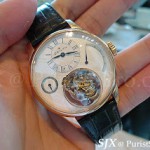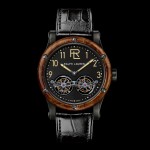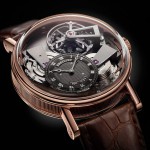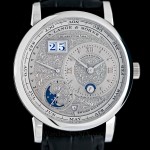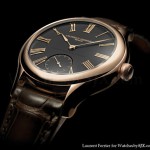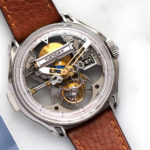Up Close: Franc Vila FVF1 C2 Tourbillon Superligero
Like a phoenix from the ashes.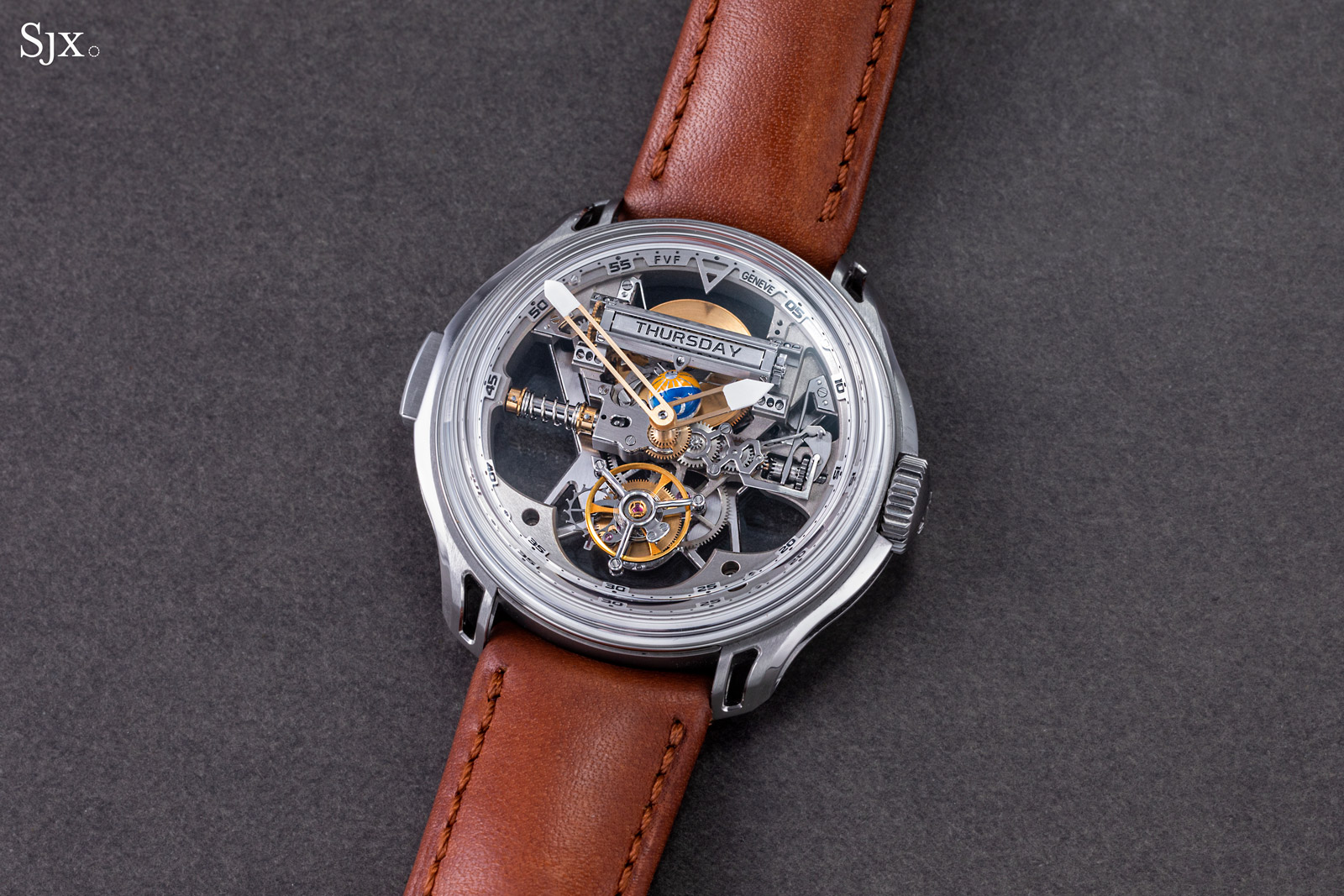
Short for “Franc Vila Founder”, FVF is a tale of redemption. Founded by the namesake designer, FVF is the second act of the Spanish watch designer, one he embarked on after his first went off the rails as many independent watch brands tend to do.
FVF’s inaugural watch is the FVF1 C2 Tourbillon Superligero. It’s an original look and at a glance there’s nothing linking it to the creations of the original Franc Vila brand – a good thing in my estimation. But look closely and hints of the earlier designs emerge.
Most importantly the FVF1 reveals itself as an impressively executed watch – the movement has an interesting construction, excellent finishing, and an original aesthetic. Mr Vila has made his comeback in style.
NB: The watch pictured is a prototype that’s been worn so it shows wear.
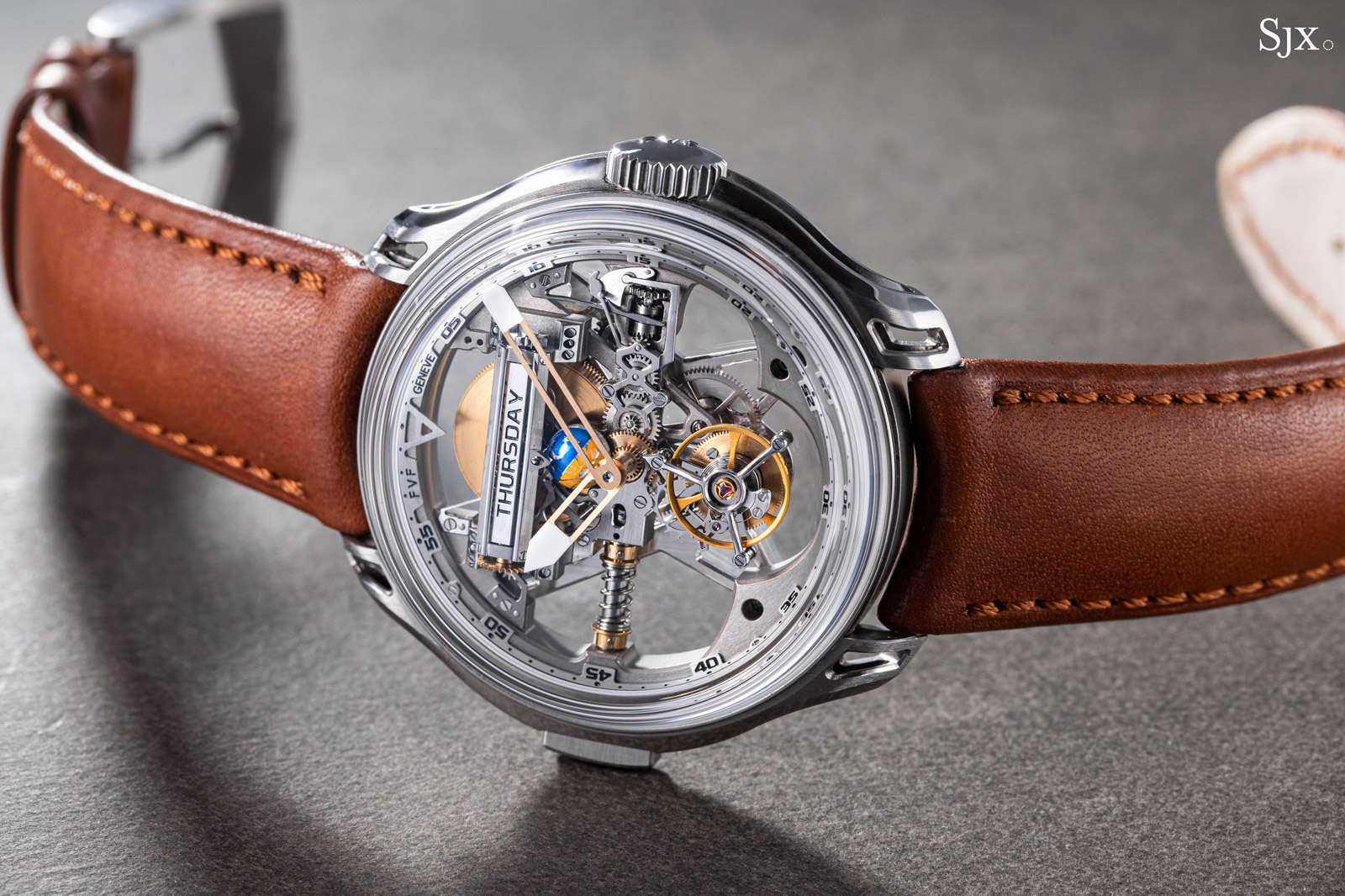
The FVF1 has a flying tourbillon, roller day indicator, day and night display, and a 100-hour power reserve
Rising from the ashes
Born in Valencia but now a longtime resident of Switzerland, Mr Vila founded his namesake brand in 2005 and rode the wave that buoyed modern, flamboyant independent watchmaking for the next decade or so. Propelled by Mr Vila’s convivial personality, Franc Vila became one of the hot brands of the era. During those heady days, it could sell several dozen tourbillons and minute repeaters a year, making it one of the top clients of now-defunct complications specialist BNB Concept.
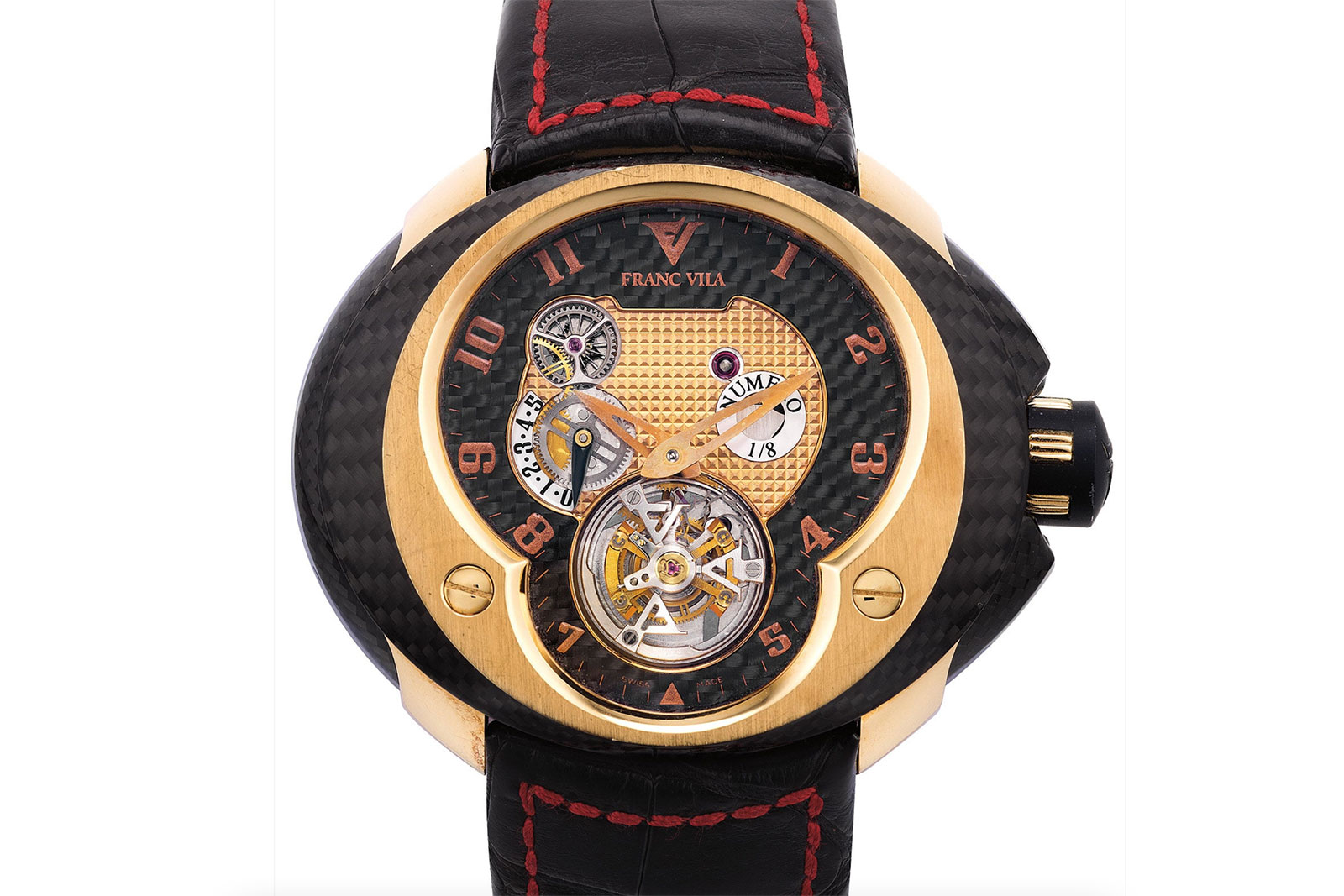
A classic from the original Franc Vila brand, the Tourbillon Planètaire in rose gold and carbon fibre composite. Image – Phillips
Typical of the prevailing style in those heady days, the watches were big, bold, complicated, and often featured generous amount of carbon fibre. Mr Vila’s signature creation then was an oval watch with a dial shaped like the outline of a skull. An industry observer once joked it resembled a monkey’s head on a strap.
But as with many independent brands of that period, boom turned to bust. Just after its 10th anniversary, Mr Vila was booted out of the brand. Business had slowed, partially as a result of a commodities market slump that drained much of the demand for extravagant watches. The always cheerful Mr Vila, however, reemerged in 2018 with his new brand – and a much improved watch.
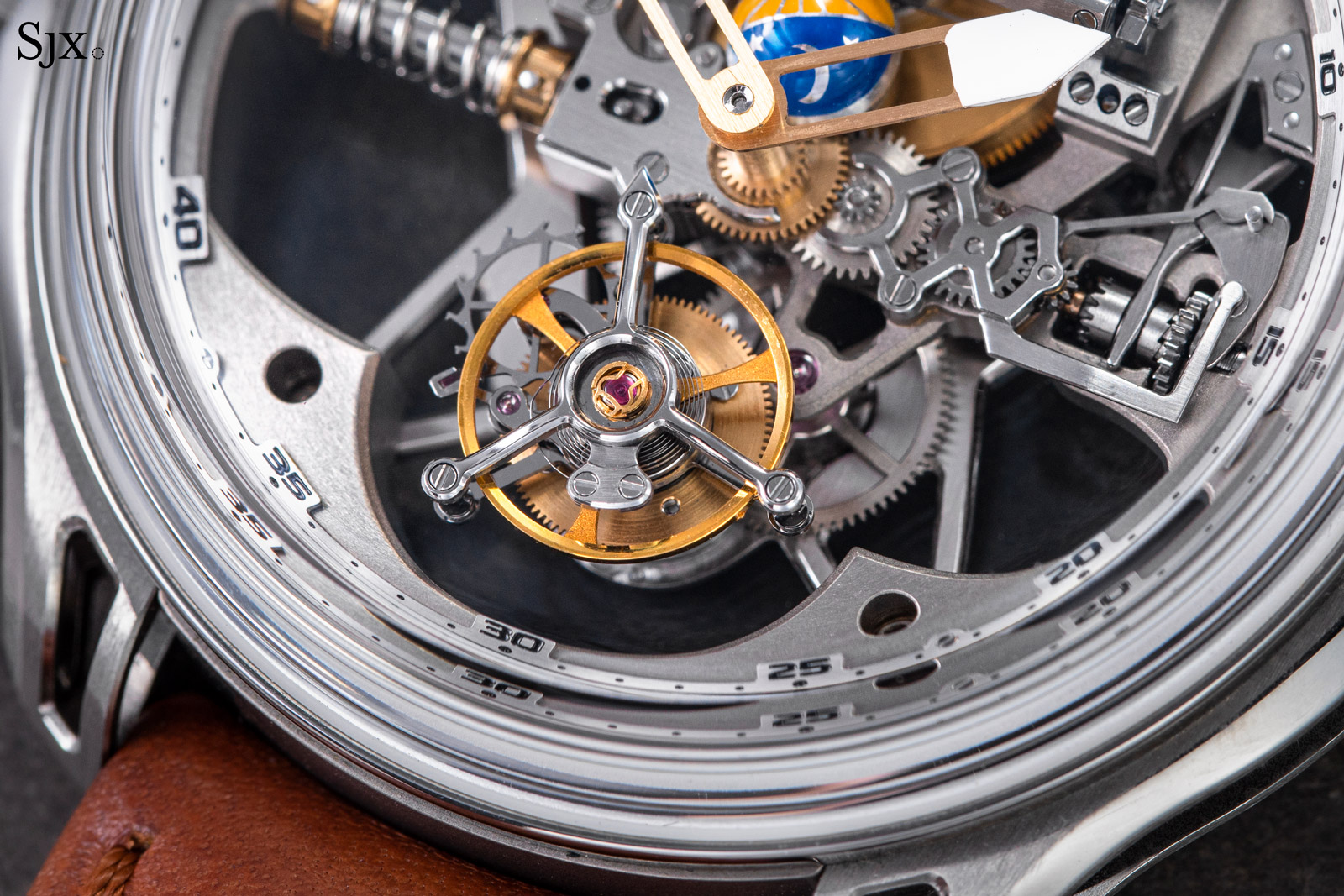
The flying tourbillon at six
Initial thoughts
I saw Mr Vila often during his tenure at his original brand. I appreciated him as a person but I had no inclination towards his watches. I didn’t like the designs and was mystified that they sold so well. More recently, I was surprised when I first saw images of the FVF1 because it looked nothing like his past designs. It looked so much better.
Then I managed to examine the prototype of the FVF1 in detail late last year. I was even more surprised at how impressed I was. To go from the peculiar ovoid case to this was a big leap and a huge step forward.
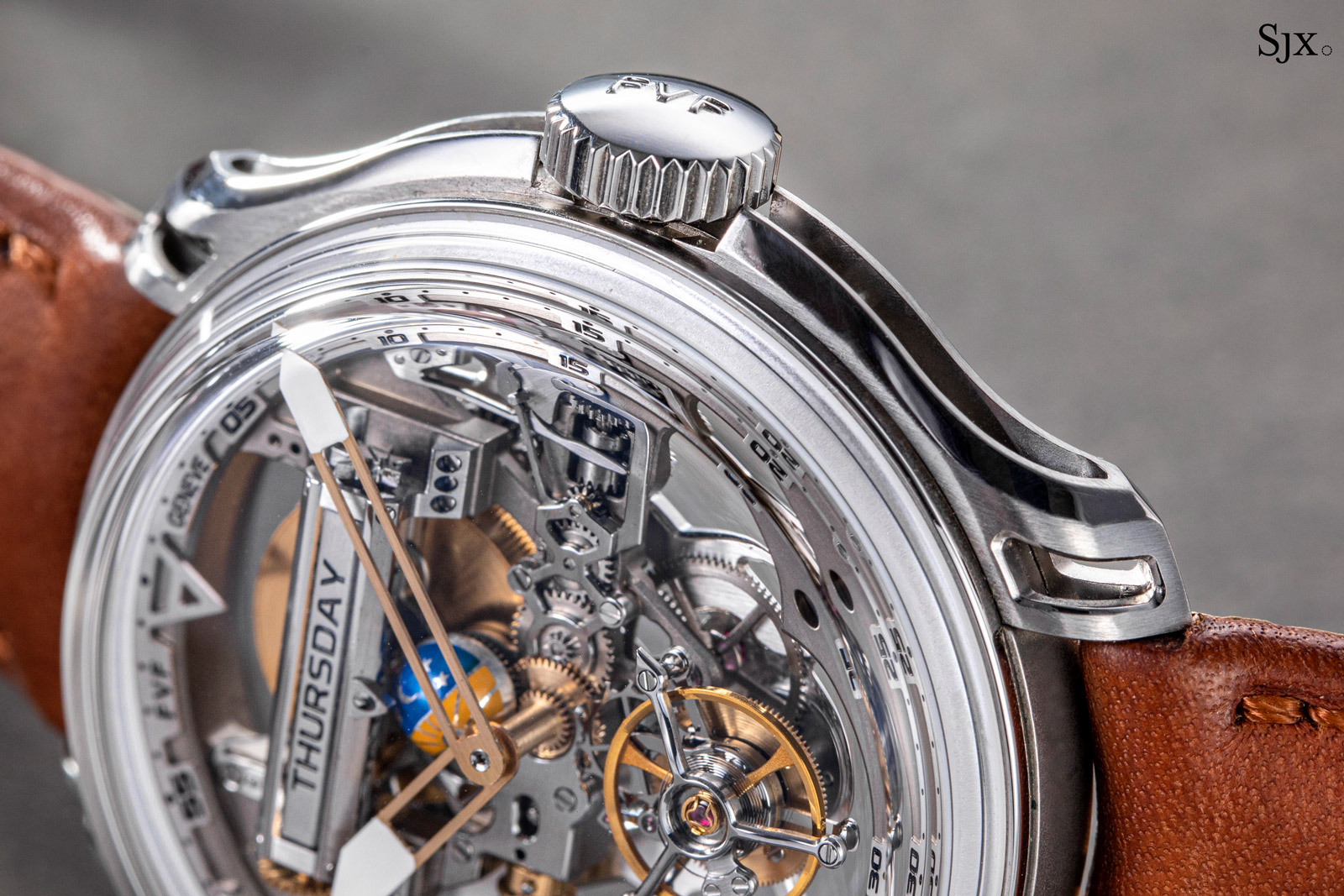
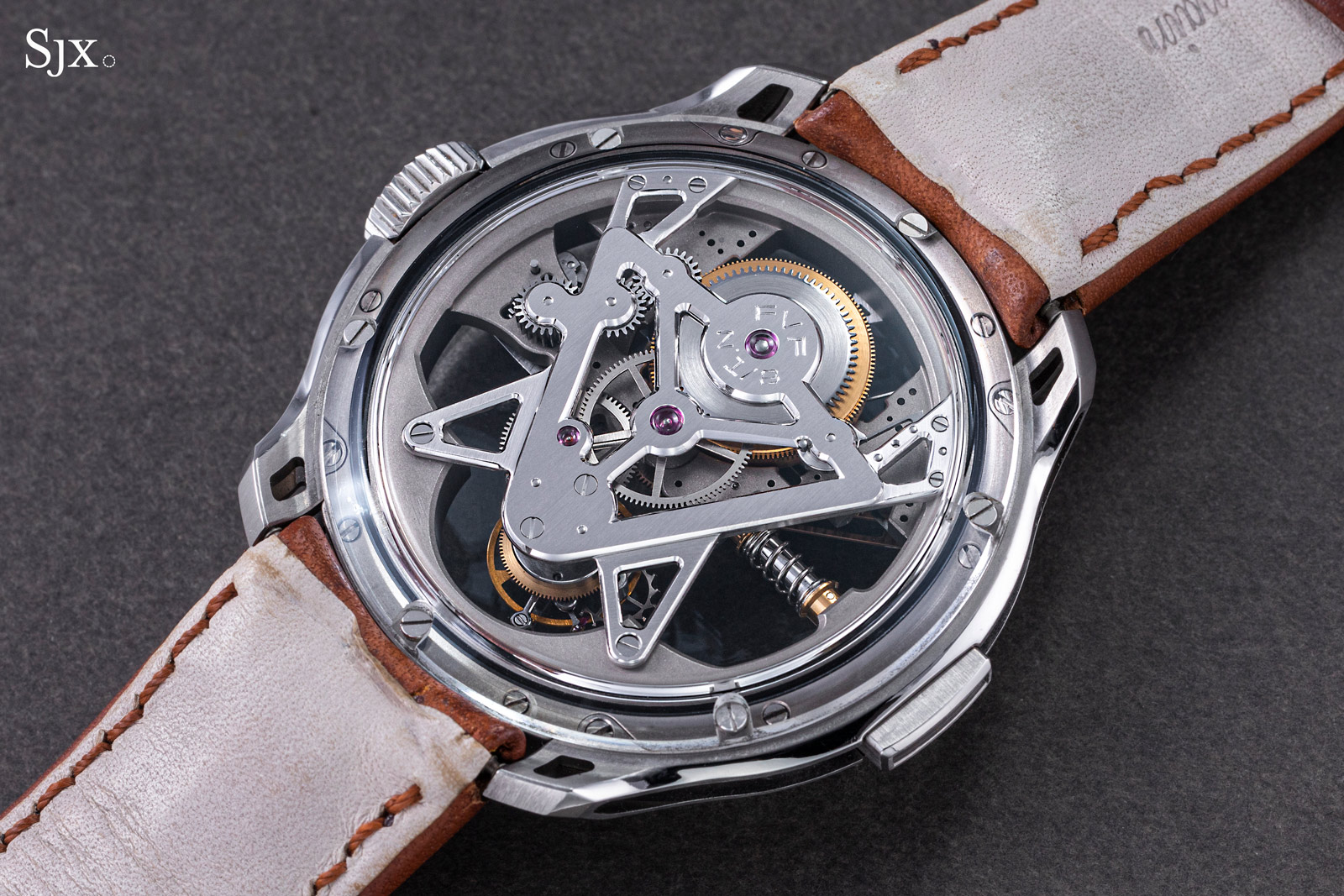
The FVF1 is smartly designed and sharply executed. Evidently attention has been paid to the design and care lavished on the finishing. The skeletonised movement is architectural, airy, and attractively styled, while the complications are intriguing and also symmetrical thanks to the vertical gear train.
Crucially, the quality of execution is high. The decoration is on point and even slightly artisanal in a few details. The gently arched tourbillon cage, for instance, is a notable example of fine detailing, as is the large, V-shaped bridge on the back.
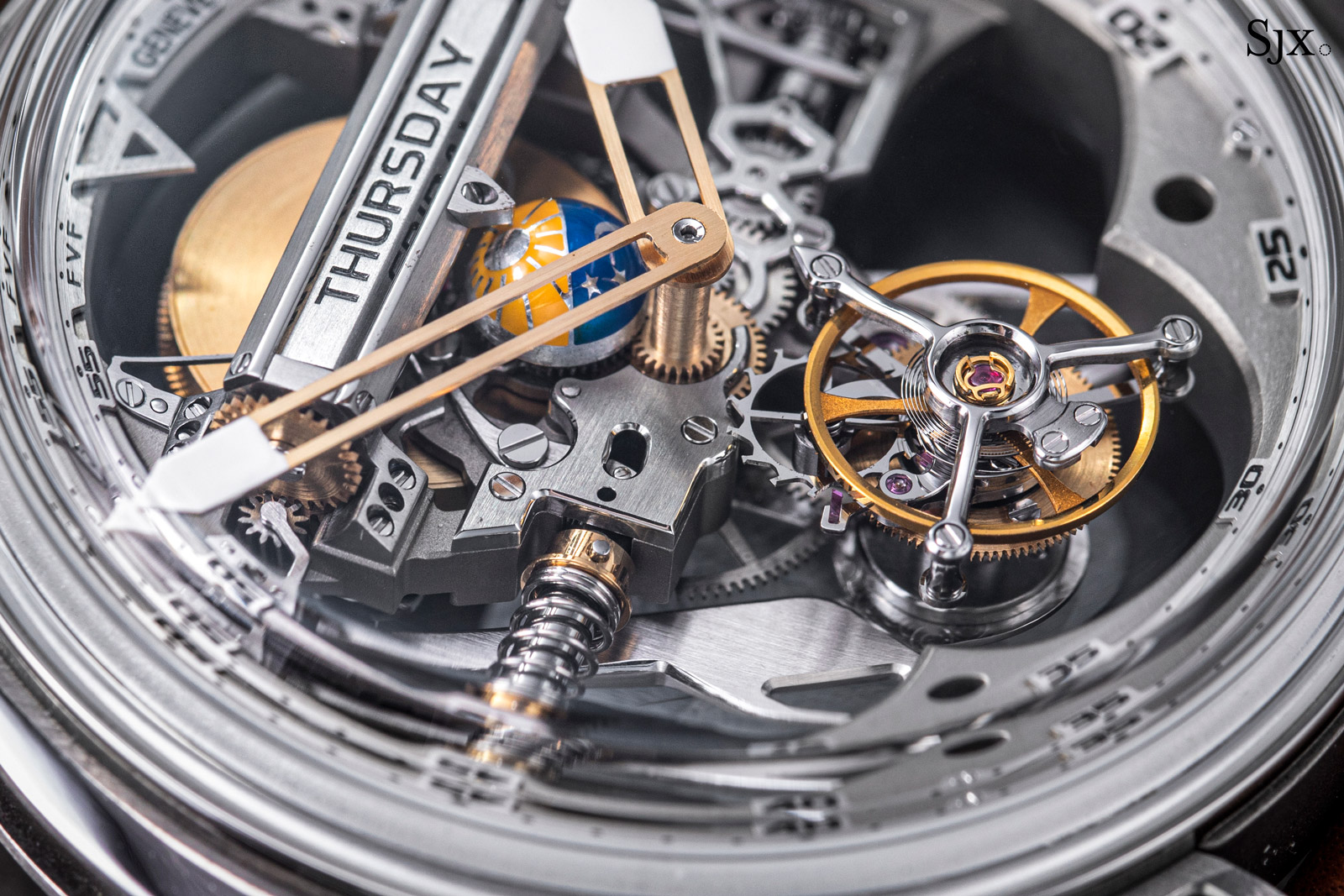
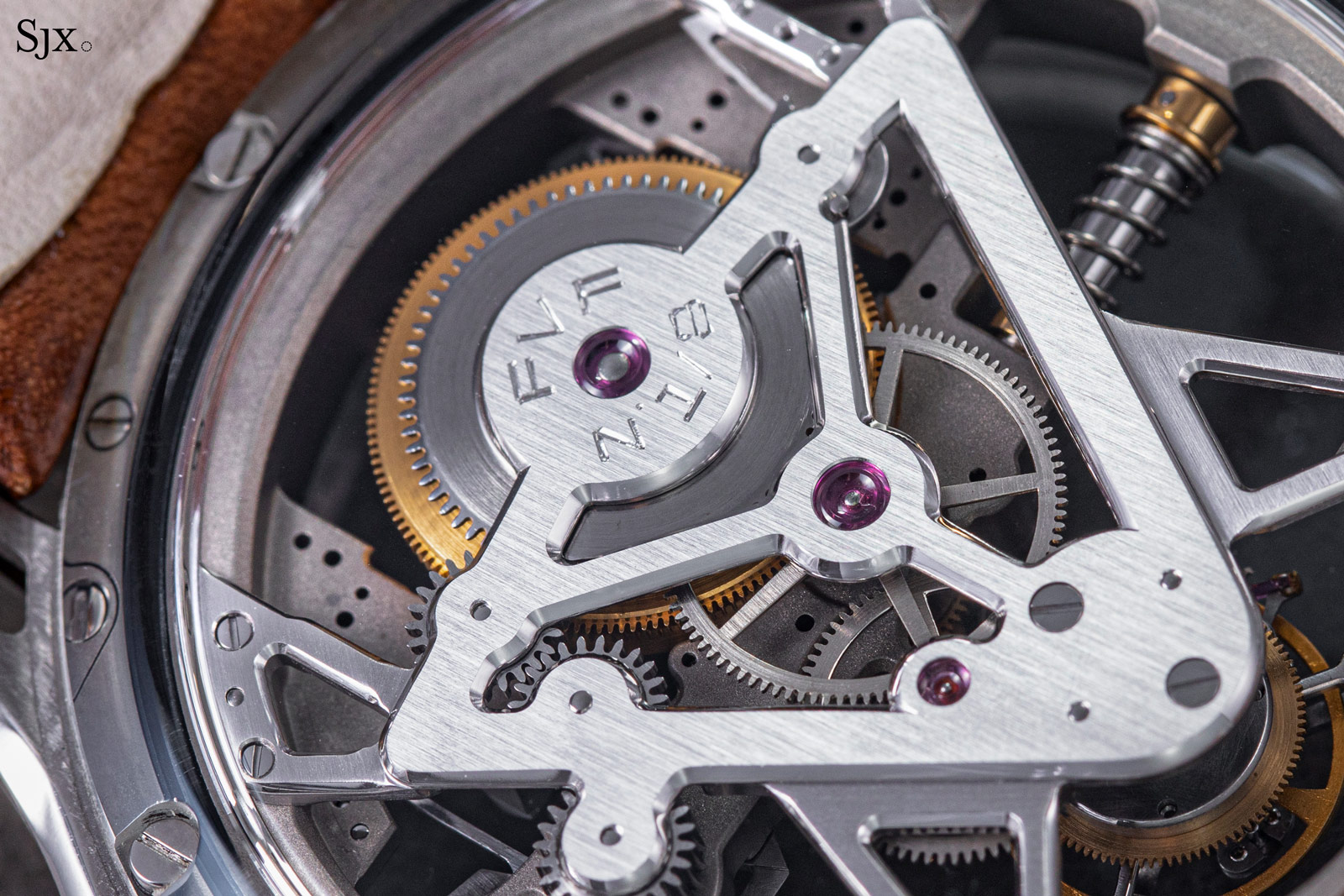
And then there’s a price, which is CHF125,000, or about the same in US dollars. For a skeleton tourbillon with an proprietary movement finished to a high level that’s certainly reasonably value.
The biggest drawback of the FVF1 is nothing intrinsic to the watch itself, but instead the historical baggage that comes with the brand. Anyone who remembers the first-generation Franc Vila watches might frown at something else with the same, or similar, name. But the FVF1 is tangibly better and so much better – it is an excellent watch.
A design evolution
Measuring 42.5 mm wide and 13.9 mm high, the FVF1 is a large watch but one that doesn’t look or feel as big as it measures because of its transparency and lightness.
The lugs are short, so much so that the strap almost touches the case, while the crystal is extremely tall, accounting for almost half the thickness. And the case is thin thanks to the large movement, and entirely in titanium.
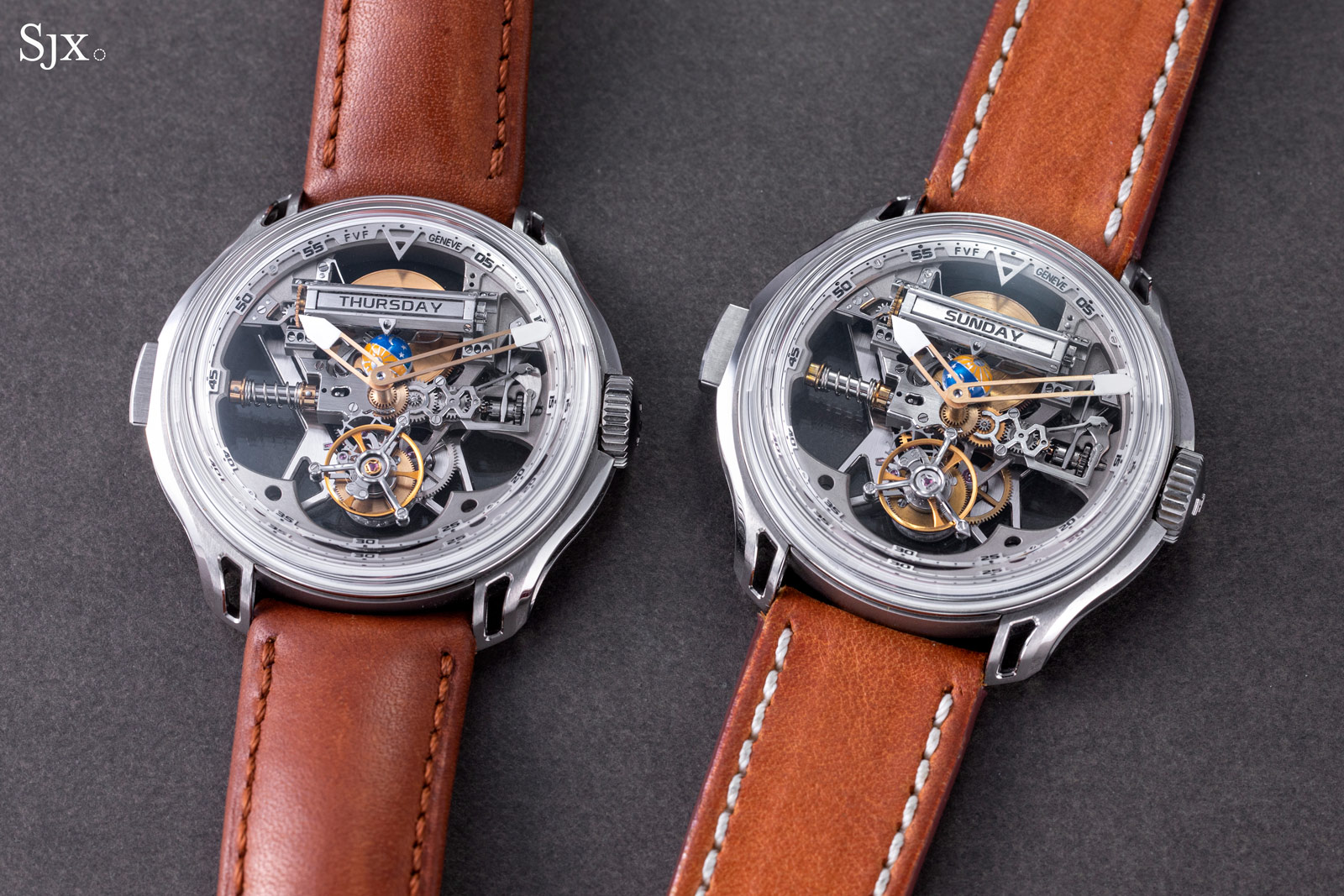
In terms of design, the FVF1 is original. Certain elements bring to mind other watches, but the sum of the parts doesn’t resemble anything else. At the same time, it has a slightly retro feel; the FVF1 looks like something from the mid 2000s, but refined and enhanced.
That said, the ghost of the monkey’s head lives inside the FVF1, albeit in a subtle manner. The twin pointed bridges on either side of the tourbillon form the recognisable shape, which is echoed on the back. And there the bridges form several Vs, large and small.
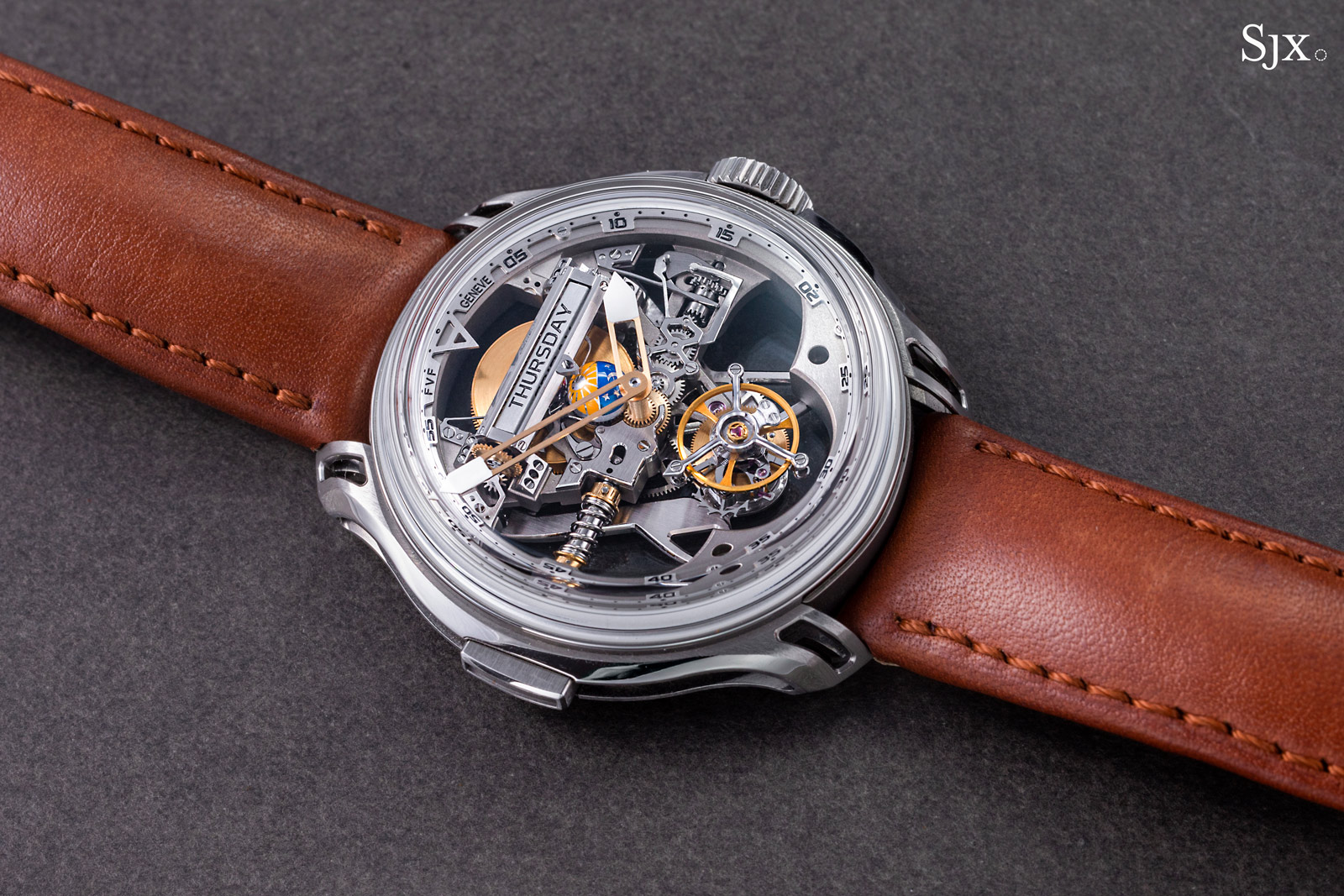
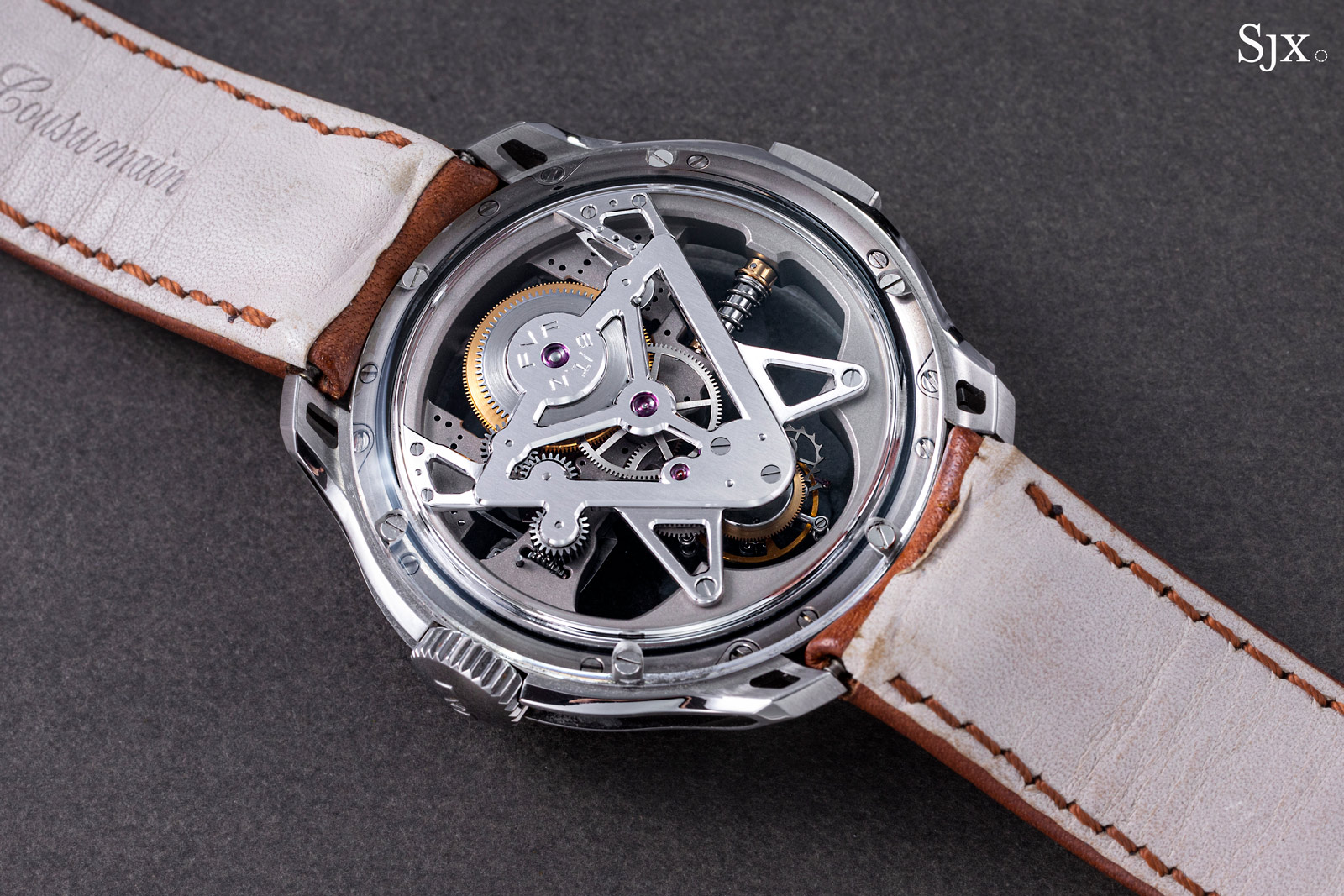
Held in place by six screws, the sapphire crystal on the back extends to the edge of the case
The case is constructed in a simple yet clever manner that maximises the view of the movement, while being modular enough to allow for customisation of individual case components. This construction gives the FVF1 its characteristic airy appearance and lightness.
It’s essentially a ring containing the movement, which is then enclosed by a domed sapphire crystal on the front and a wide, edge-to-edge crystal on the back. Lastly, a pair of open-worked brancards are secured to each flank to create the lugs.
The result is a lightweight case with enough details to make it interesting. At the same time, the case is minimal enough that the movement is presented to maximum effect. That said, while the domed crystal is an appealing feature on paper, it does leave the watch looking slightly bulbous from certain angles.
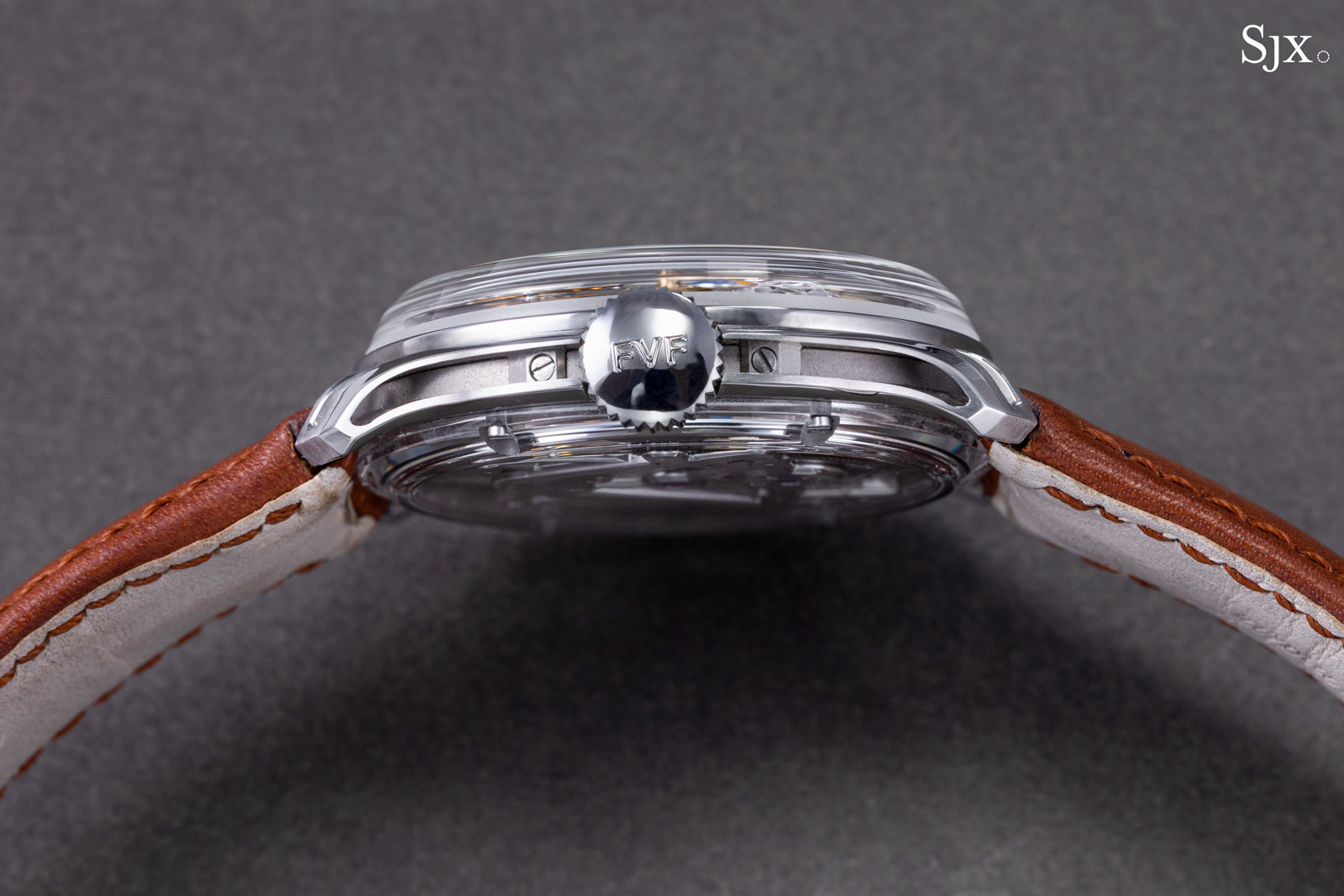
The brancards are each secured by four screws, two on the side and another two on the back
Unusual complications
Being a designer rather than a watchmaker, Mr Vila turned to a constructor in Geneva to create the movement inside the FVF1. Similarly, the movement parts are produced and finished by specialists in the city and the surrounding region.
The respected but unnamed constructor did well in arranging the mechanical components to create a distinctive aesthetic, while exaggerating certain components for visual effect. One example is the bridge for the keyless works that’s been open-worked so it resembles an expanding arm with a clamp at the end.
The movement is also technically interesting. With a single barrel it manages a 100-hour power reserve – that’s four days – and incorporates a novel complication, a day-of-the-week roller, as well as a day and night sphere.
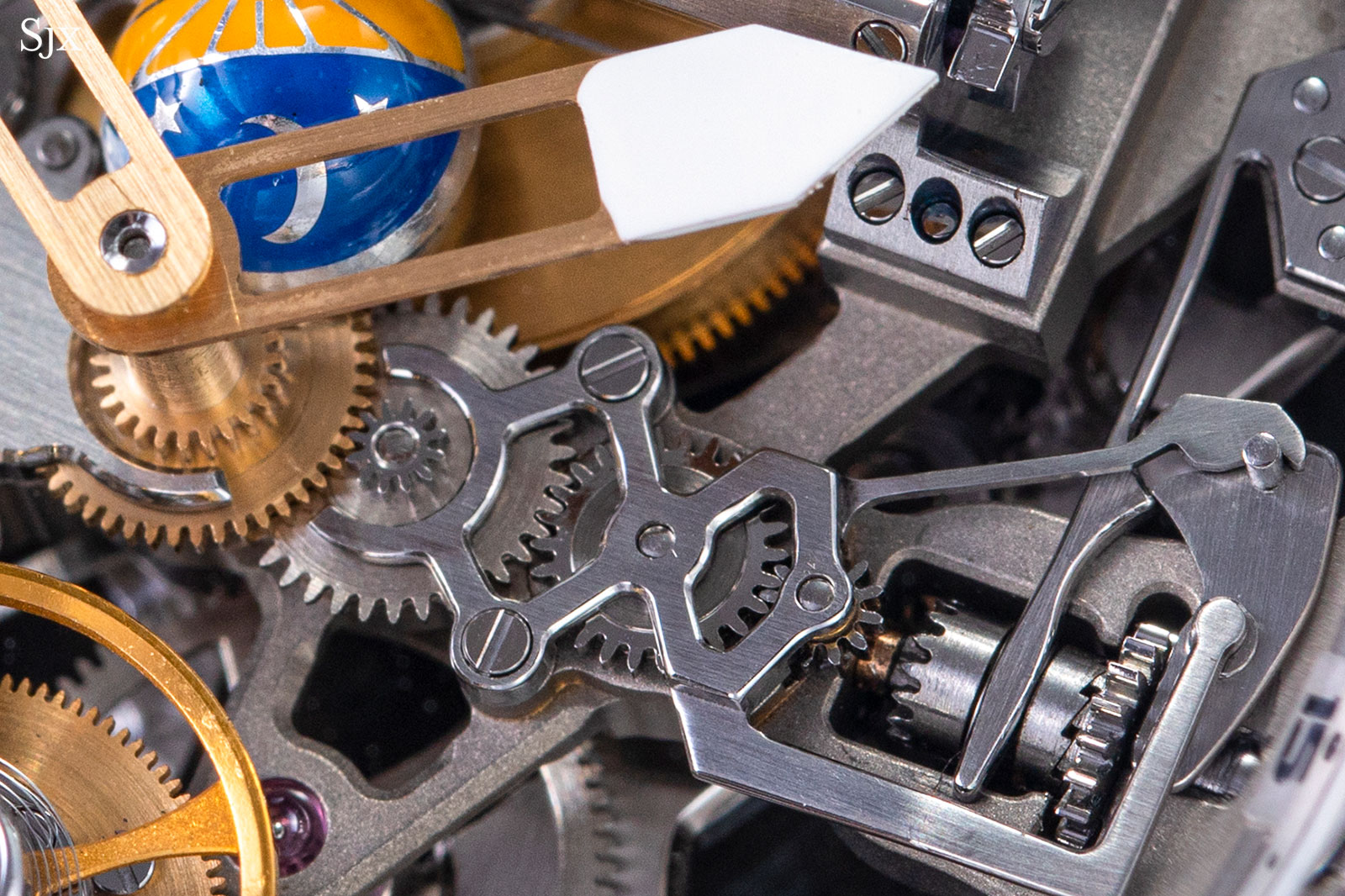
The fancy bridge for the keyless works
The movement is laid out vertically, as is usually the case for tourbillons that sit at six o’clock. Starting with the mainspring at 12 o’clock, the flows downwards to the flying tourbillon regulator at six, with the complications and time display sitting in-between. As a result, the movement has a pleasing visual balance on both sides and almost perfect symmetry on the back.
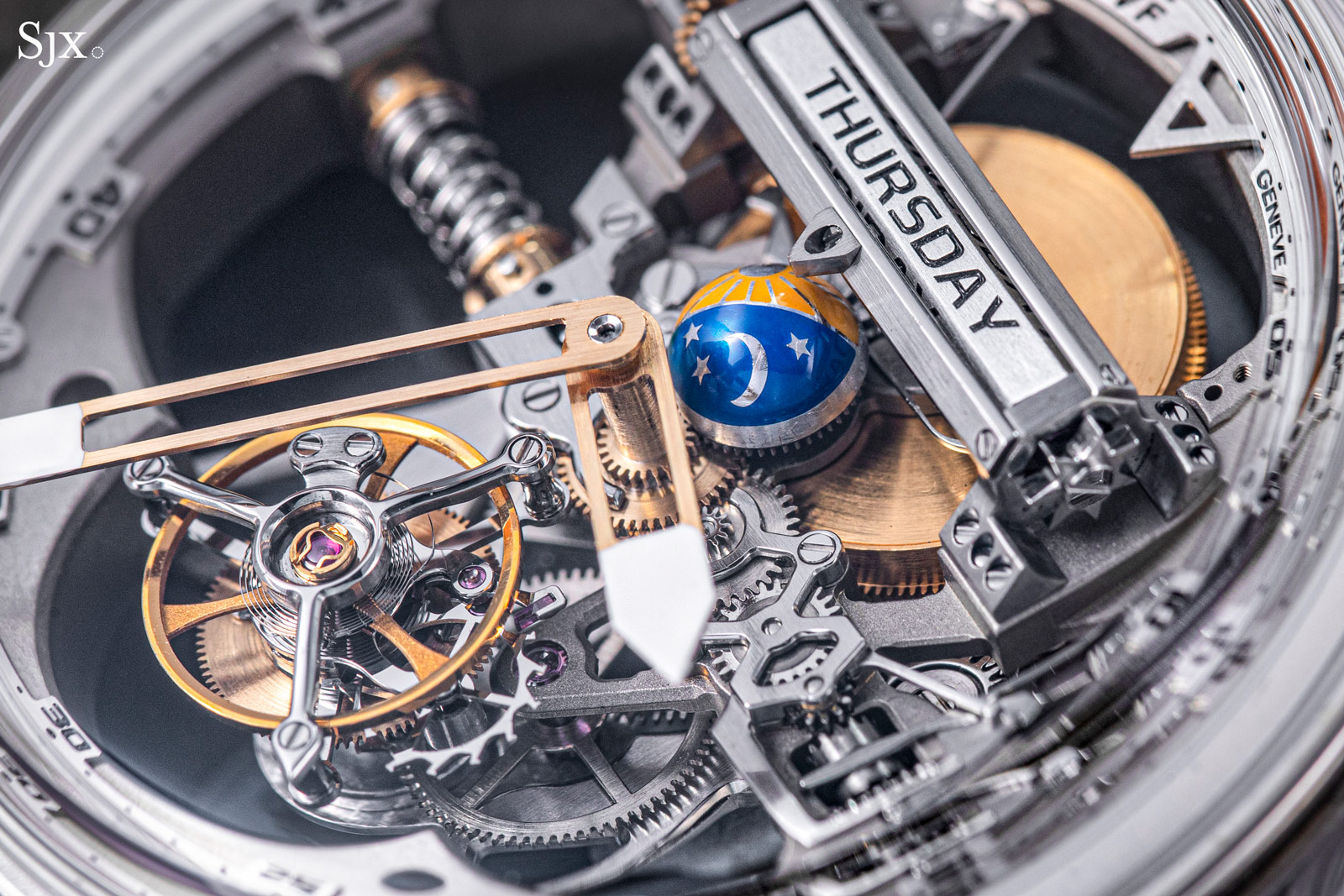
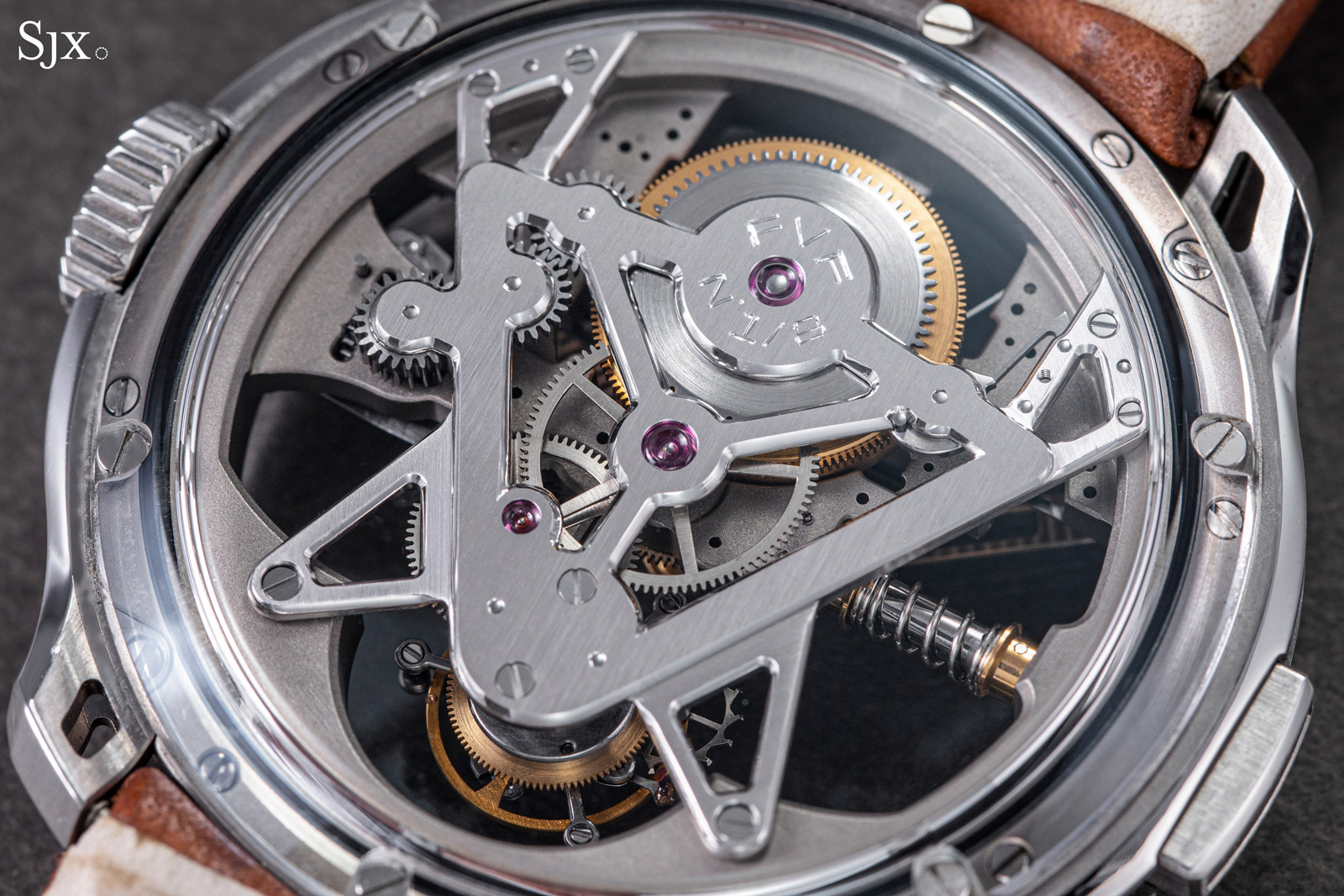
The day roller is one of the key elements of the design, albeit being a complication of modest practicality. Sitting inside a large frame with a conventional gear at one end and a star-shaped wheel at the other, the roller is where the brand name would be on a conventional watch. This means the FVF branding is subtle, having been relegated to 12 o’clock.
Because the roller is long and tall, it becomes a major structural element of the movement. It sits some distance over the barrel, creating strong visual depth for the movement. However, that means the hands have to sit high up to clear the roller, which explains the highly domed crystal.
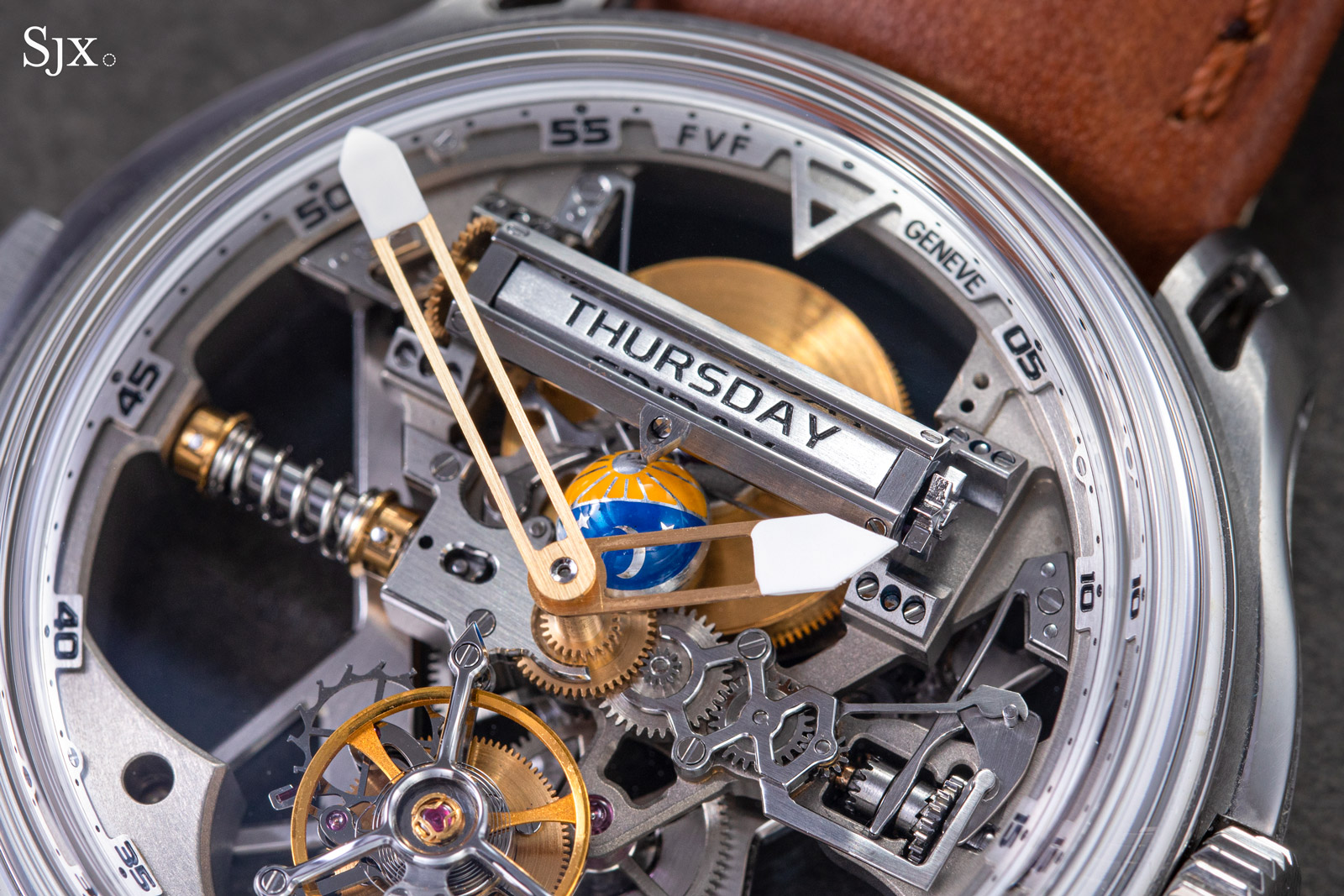
The day display is also impressive because of its excessive execution. It sits in a disproportionately large frame that’s resembles a tiny machine in miniature.
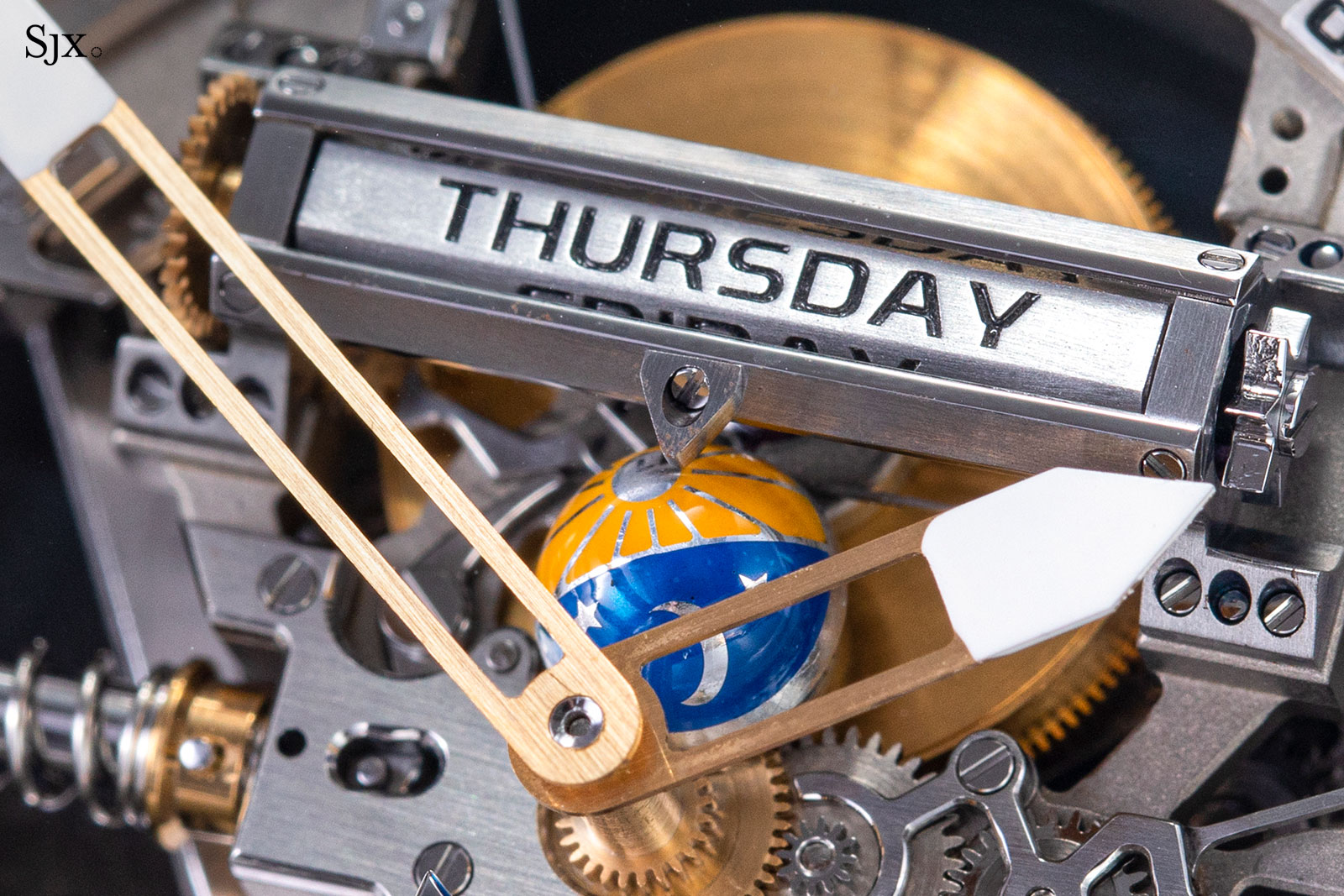
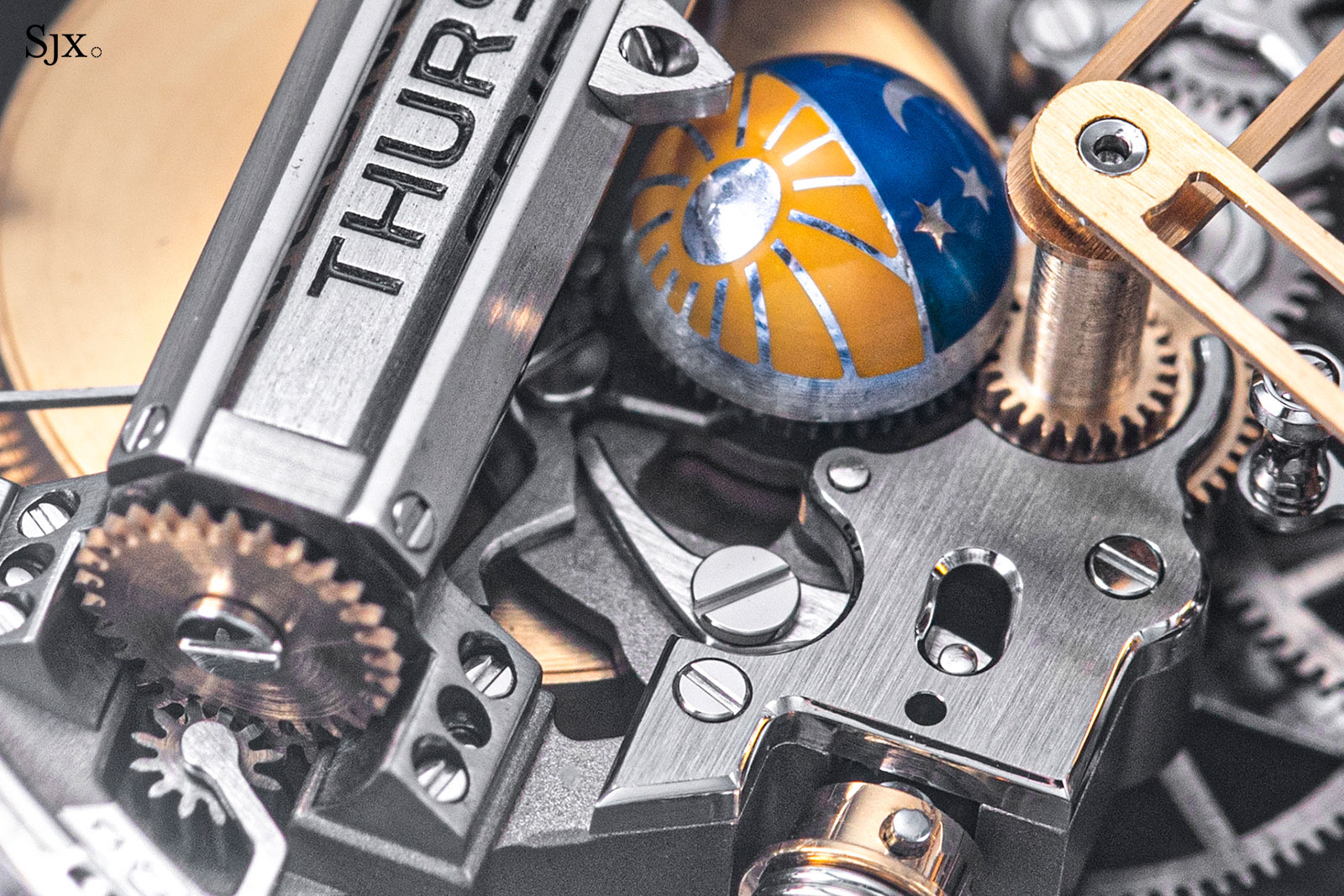
The frame sits on four feet at each of its corners; each foot is secured by a pin and two screws
The huge spring piston visible at nine o’clock is actually the actuation mechanism for the day roller. It’s an elementary mechanism, but done such that the spring piston forms a key part of the movement’s architecture. The size of the spring piston also means it serves as a visual balance for the keyless works at three.
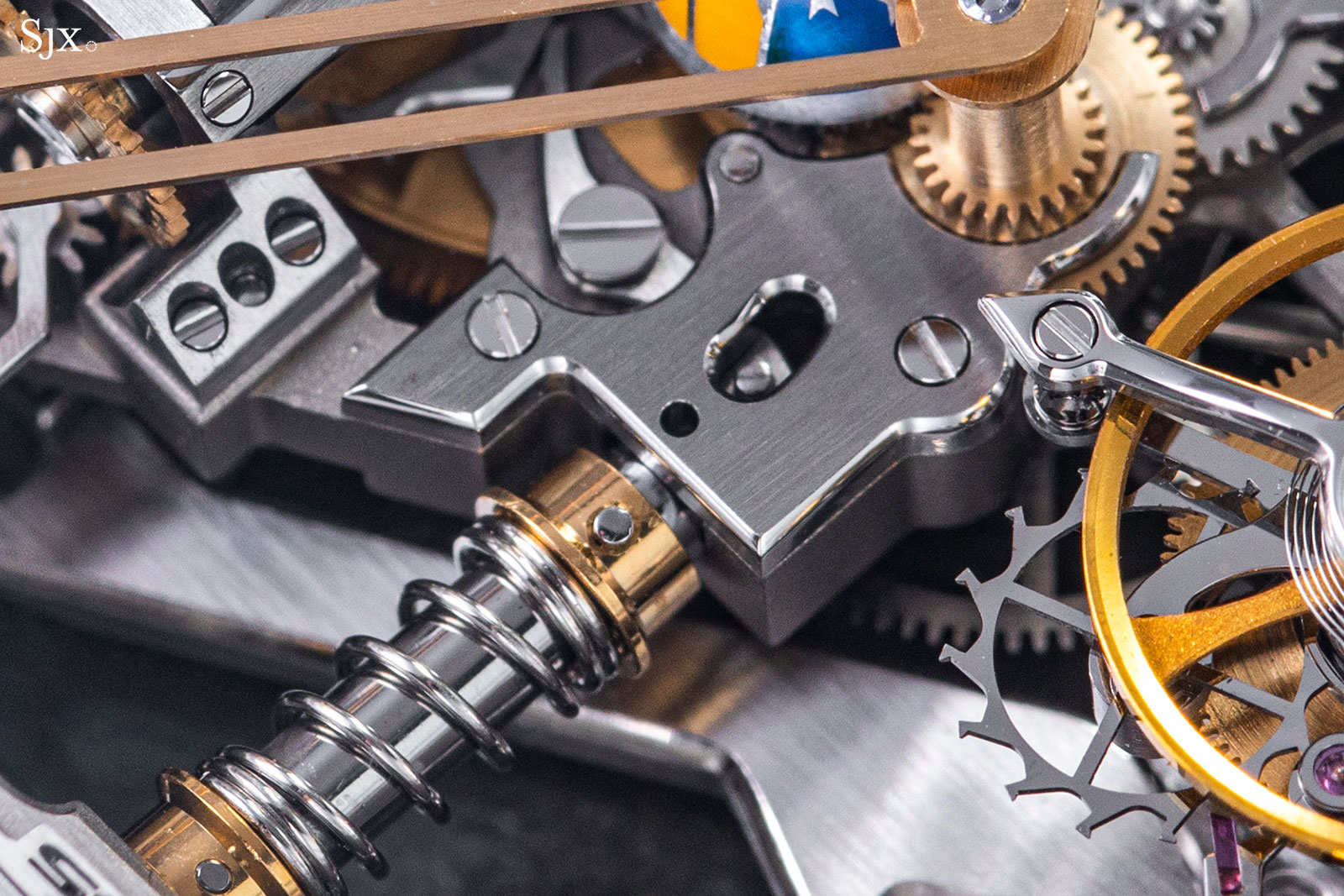
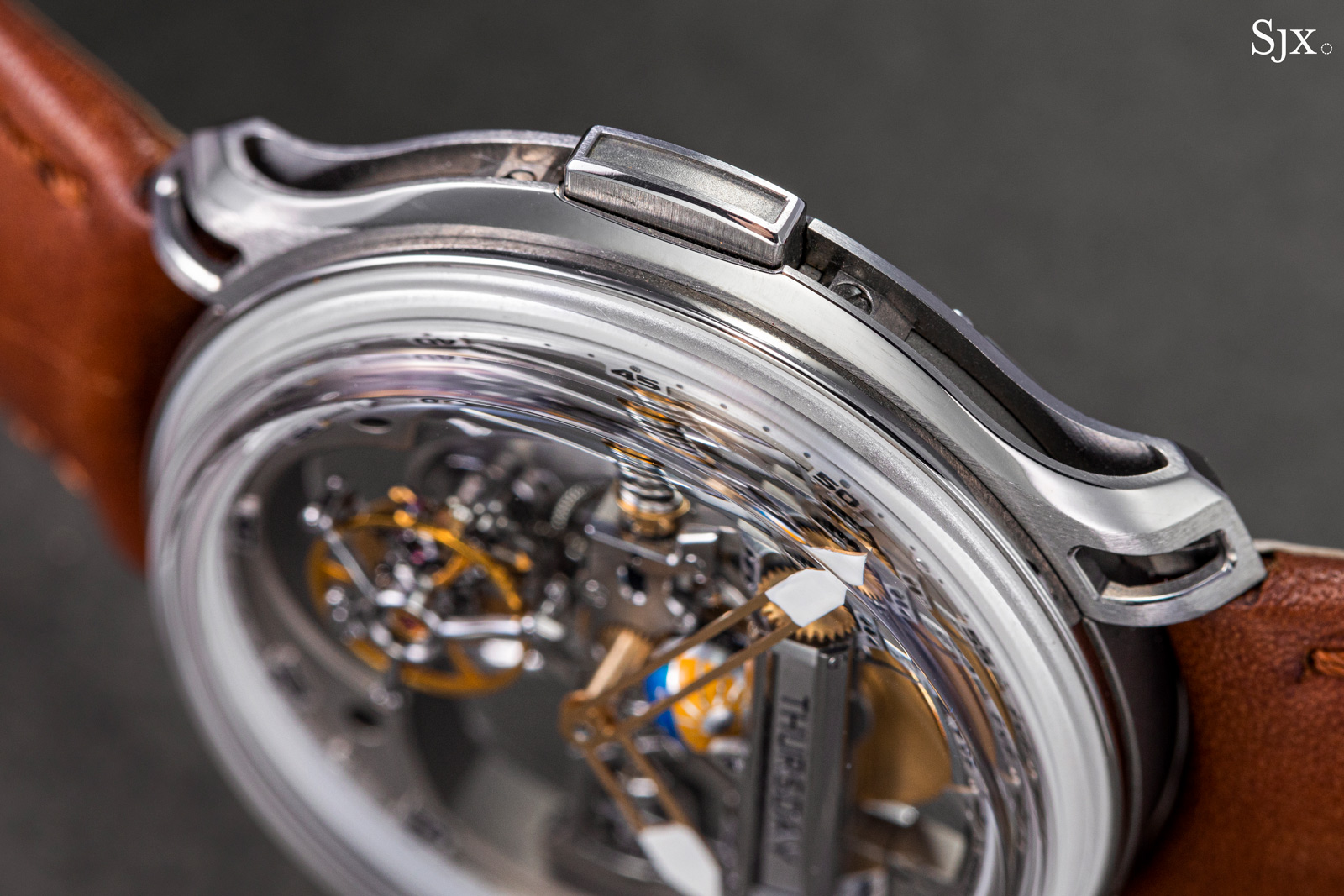
Pressing the button on the case side advances the roller by one step
Just below the day roller is a rotating hemisphere that functions as a day-night indicator. Covered in lacquer – yellow for day and blue for night – the hemisphere makes one rotation every 24 hours, moving in tandem with the hands.
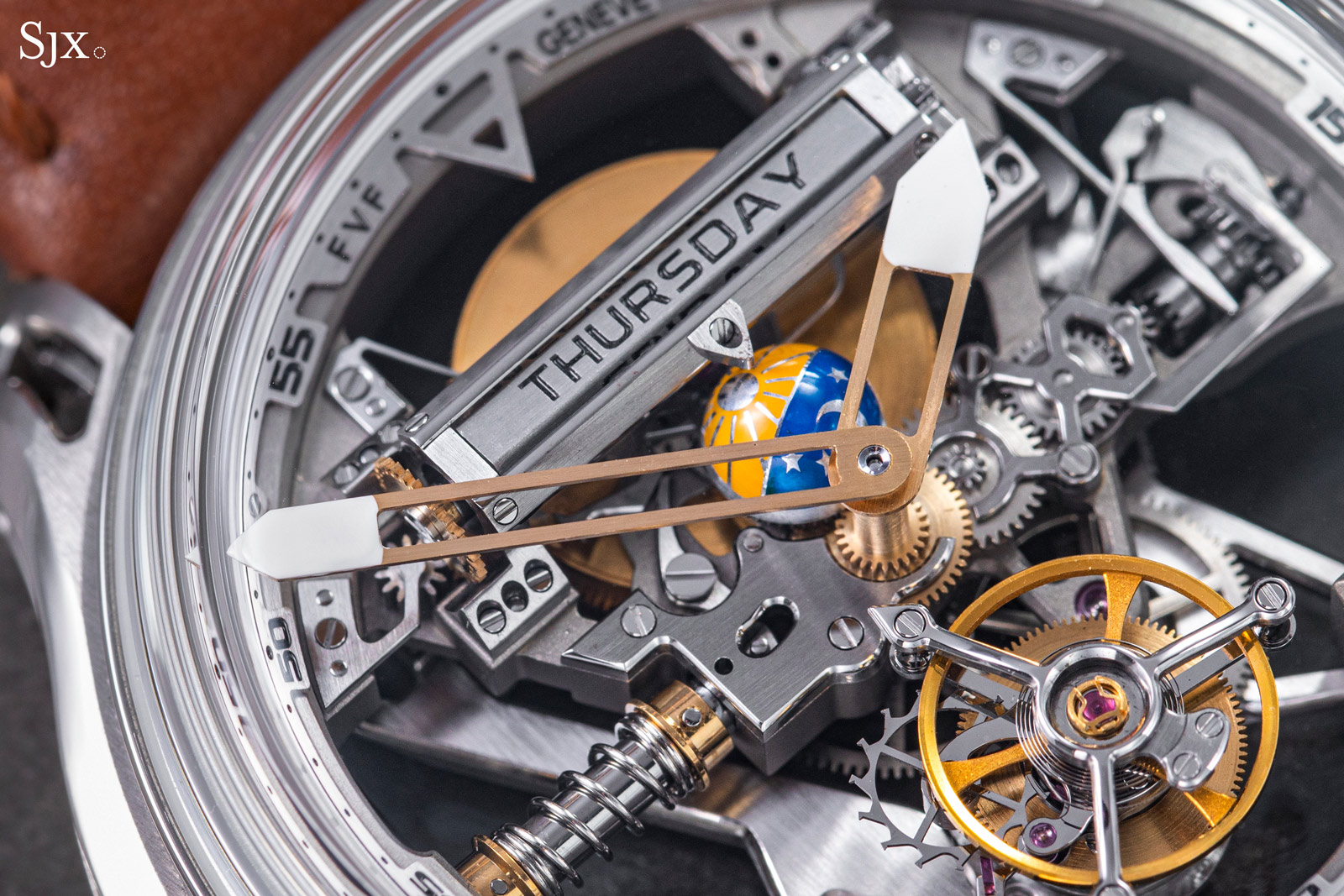
Of all the elements of the movement, this is one of the least elaborate. I would have preferred something more artisanal in nature and more monochromatic in colour. For instance, a hand-engraved sphere in a single colour with the motif to differentiate between the two halves of the day.
Similarly, the open-worked hands are simple, perhaps a bit too simple. Although legibility is excellent and the minimalist hands don’t get in the way of admiring the movement, they are too plain for the design.
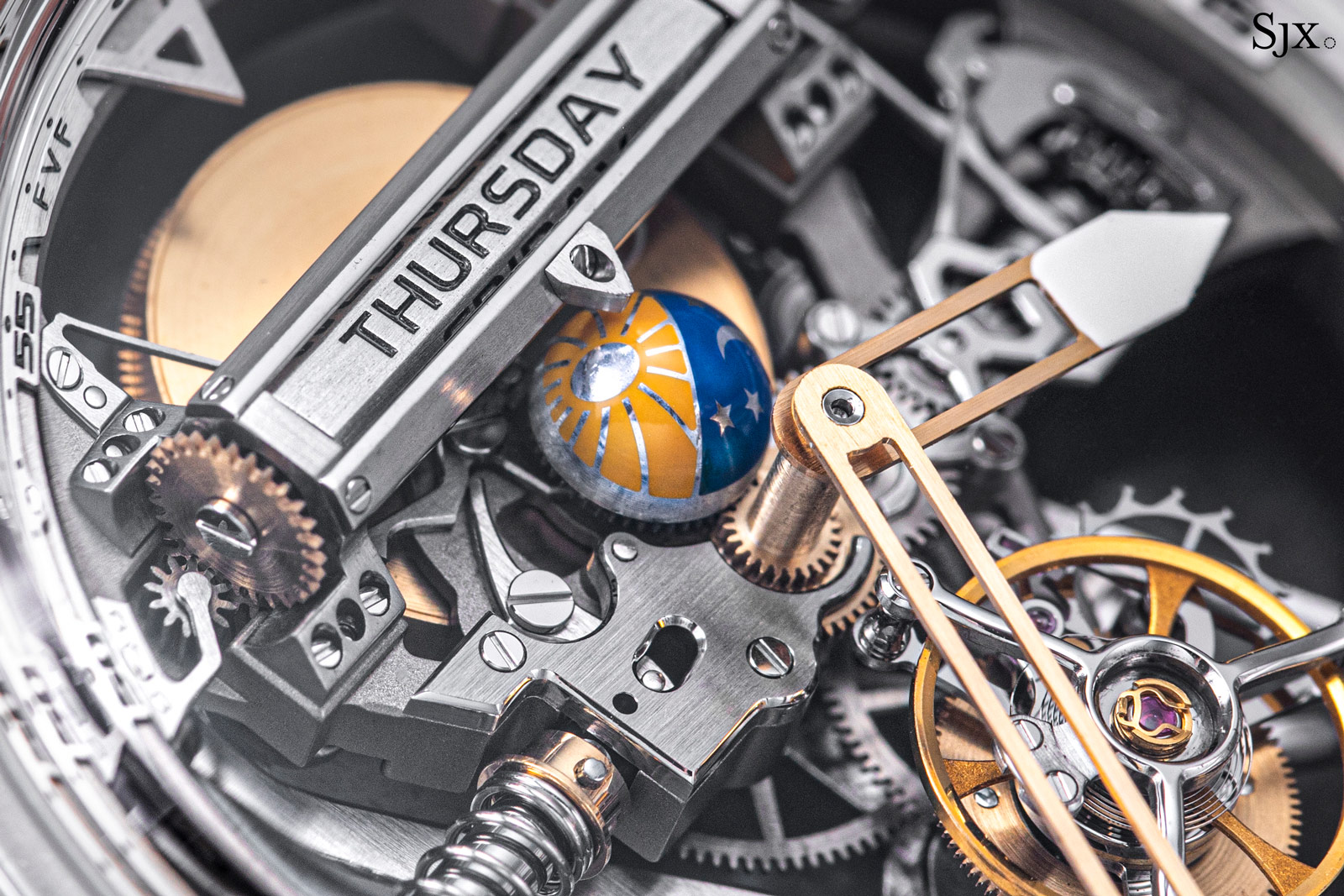
The most complex mechanism in the movement is the flying tourbillon at six. It’s a straightforward tourbillon with a three-armed cage containing a basic Glucydur balance. In terms of function it performs well, but aesthetically it can be better.
Relative to the size of the movement the tourbillon is small and would certainly be more attractive with a larger diameter. And a screwed or variable inertia balance would equally contribute to more appealing aesthetics.
But the tourbillon is saved by its cage, which is surprisingly elaborate, albeit in a discreet manner.
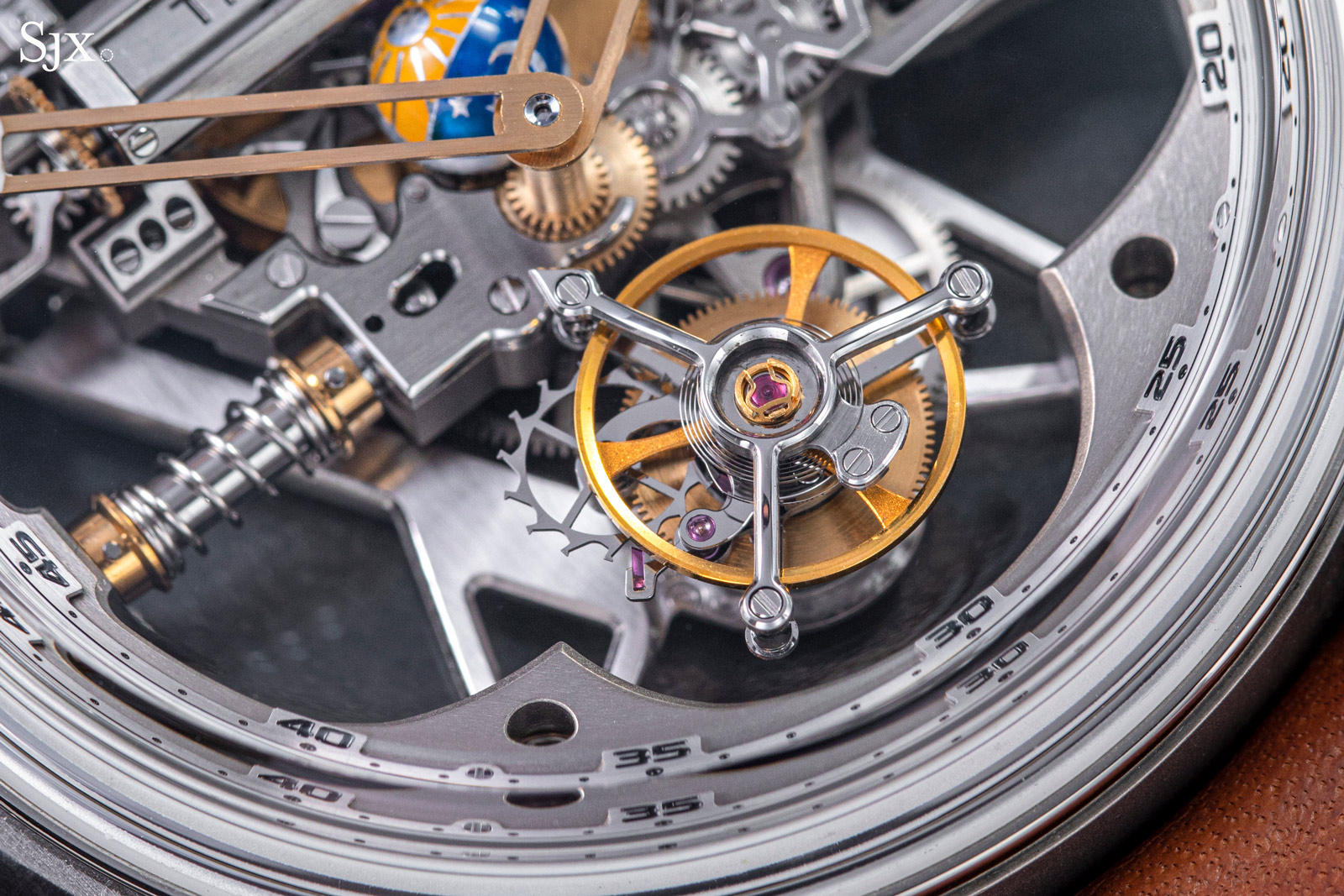
Only from the side is is the curved profile of the cage apparent. Each of the arms gently flow downwards, which certainly makes finishing them more of a challenge than if they were straight.
Despite the unusual form, the cage is finished well. It’s all mirror polished, right down to the bevelling on the arms and the countersink for the central axis. Even the undersides of each half of the cage are mirror polished.
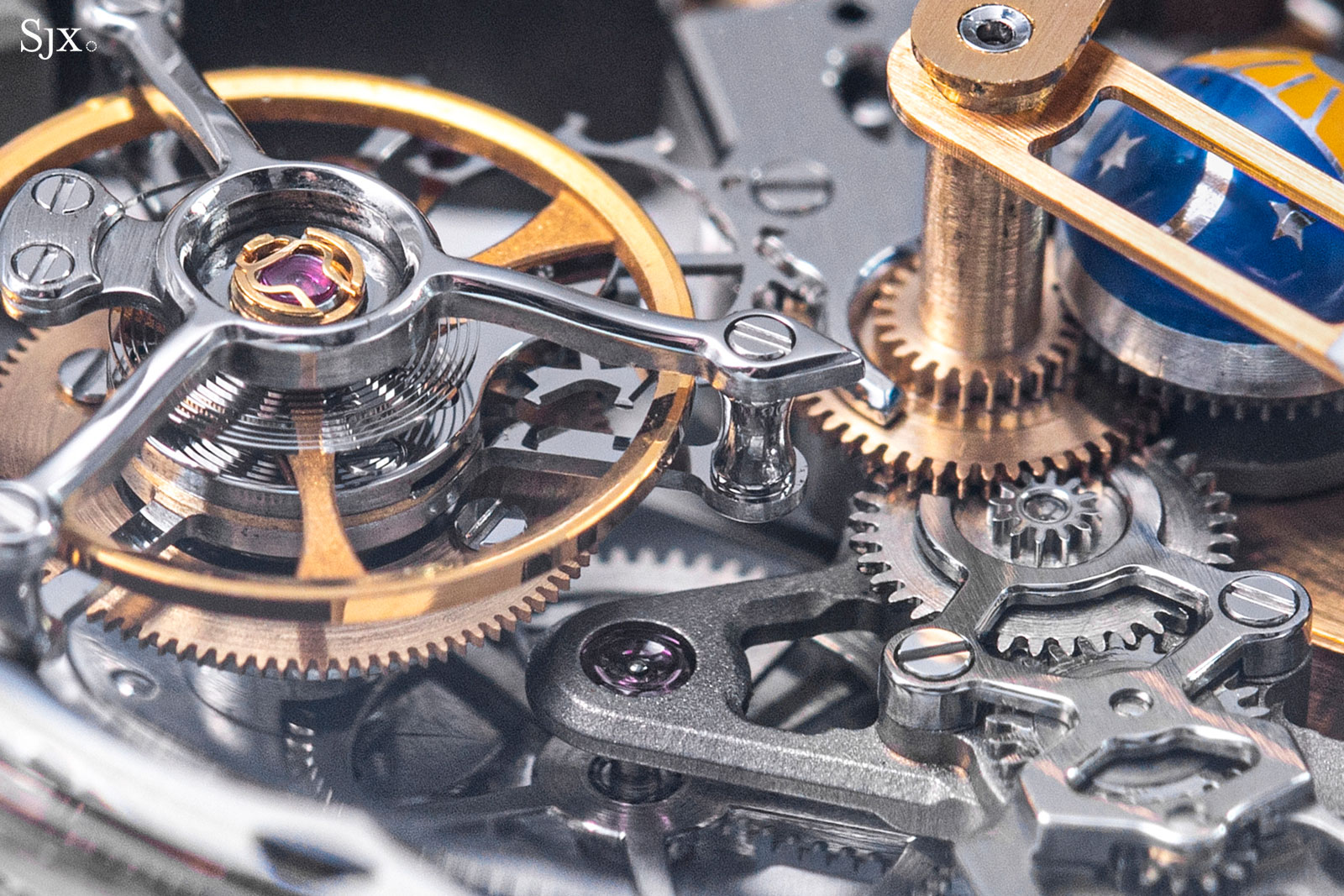
The subtly curved cage and the bridge for the keyless works (lower right), both of which contrast against the frosted, dark grey base plate
The rest of the watch is equally well finished. The decoration is comparable to movements bearing the Poincon de Geneve, made by establishment brands like Vacheron Constantin and Chopard. In other words, the calibre has been decorated by hand with a mix of electric and manual tools.
While the finishing is fine, the architecture of the movement is almost industrial with its over-engineered elements, exemplified by the day roller. This creates contrast in colour and texture that is appealing.
The spring piston, for instance, sits right next to a steel bridge that’s straight grained on top, bevelled along all its edges, and secured by two screws with chamfered slots and edges. And the steel bridge in turn sits on the base plate that’s entirely frosted, giving it a dark grey matte finish.
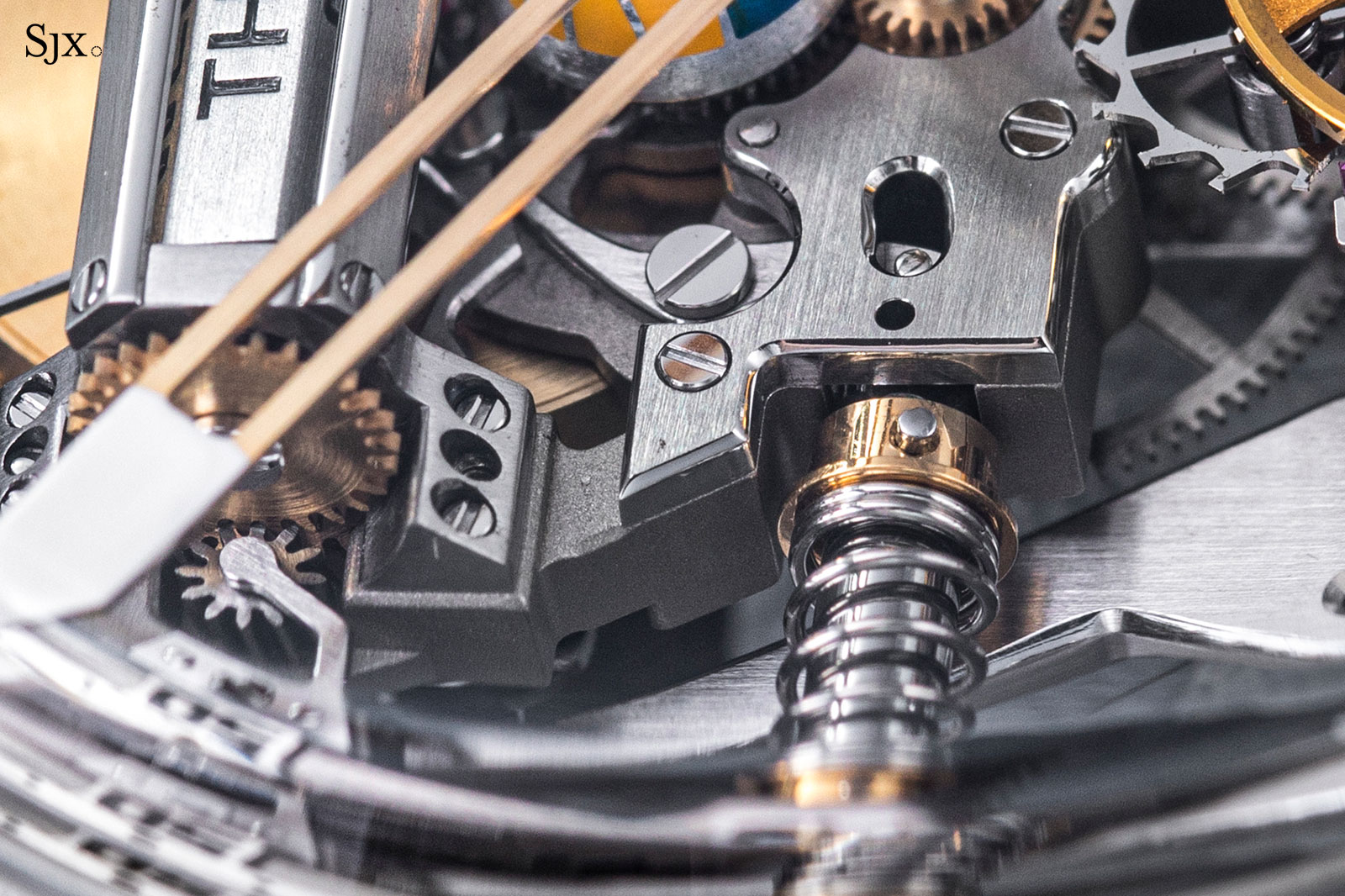
Over on the back, the landscape is less densely packed. Instead it’s dominated by a large, thick bridge that holds the underside of the barrel, centre wheel, and tourbillon.
It’s cleanly finished with a straight grained top along with the requisite polished, bevelled edges. But it also incorporates three sharp, inward angles along its bevelling, which add an element of artisanal hand finishing to the whole.
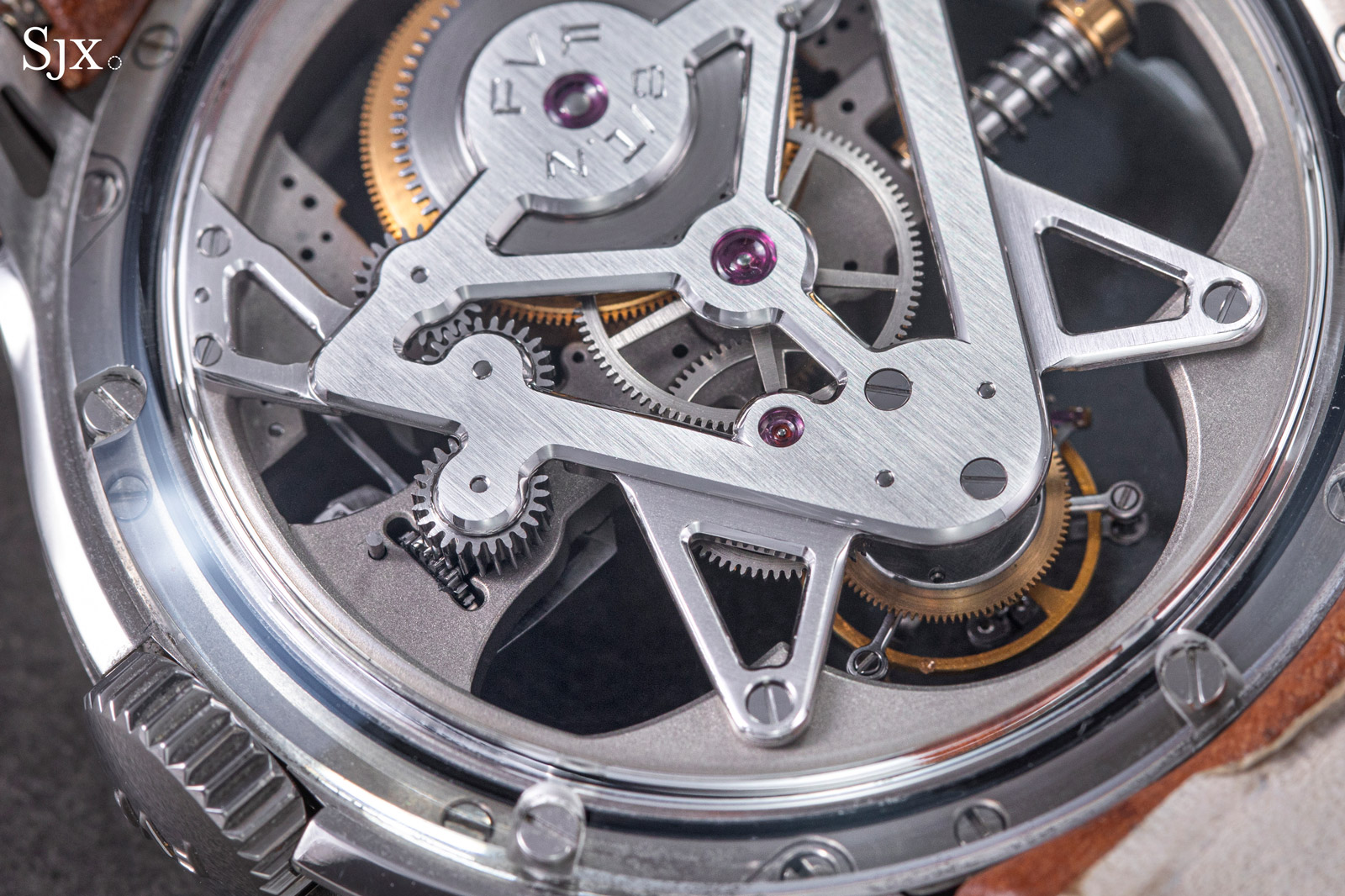
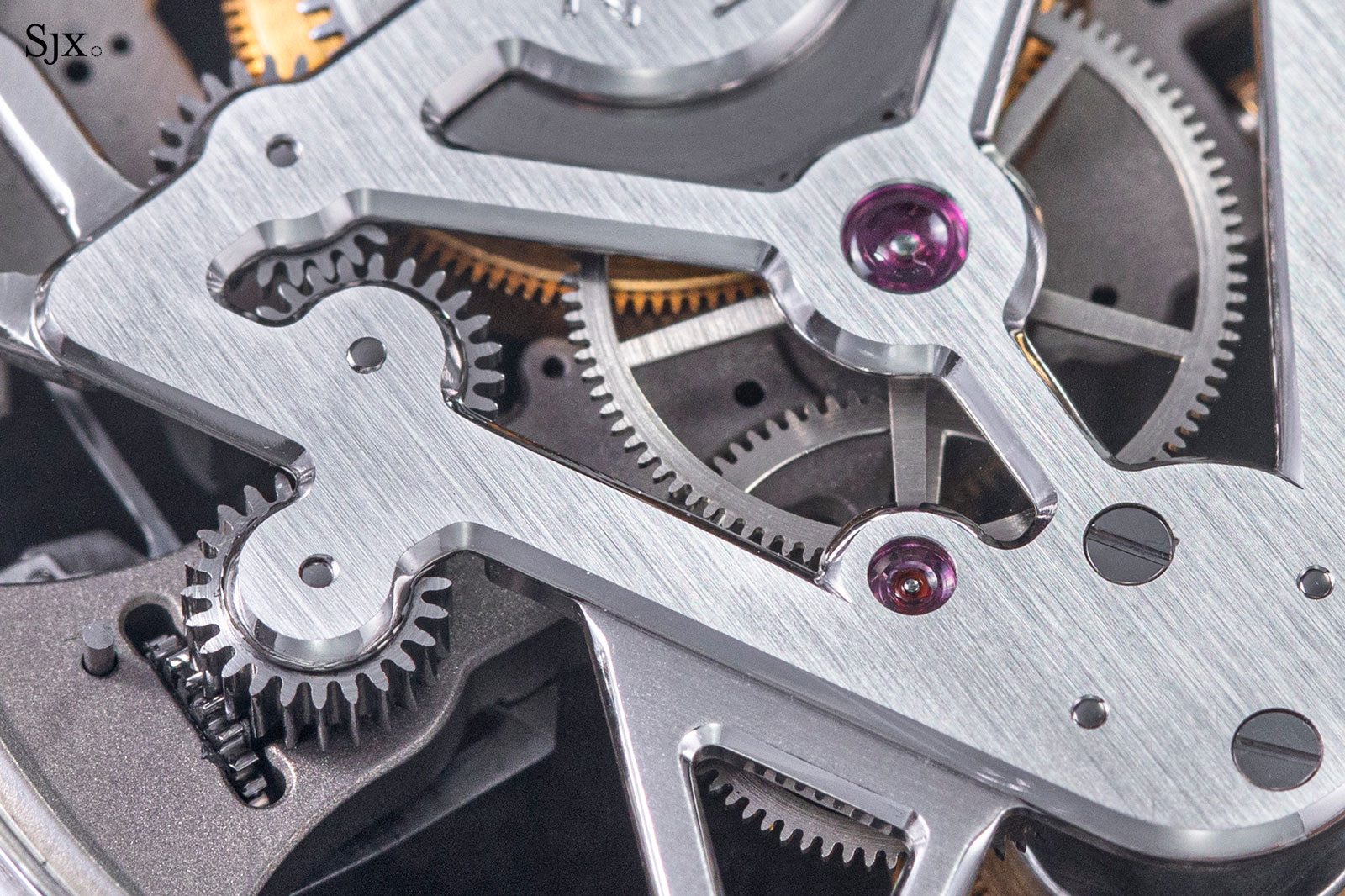
The lower point of the “V” features twin inward angles along the bevelling on its inner edges
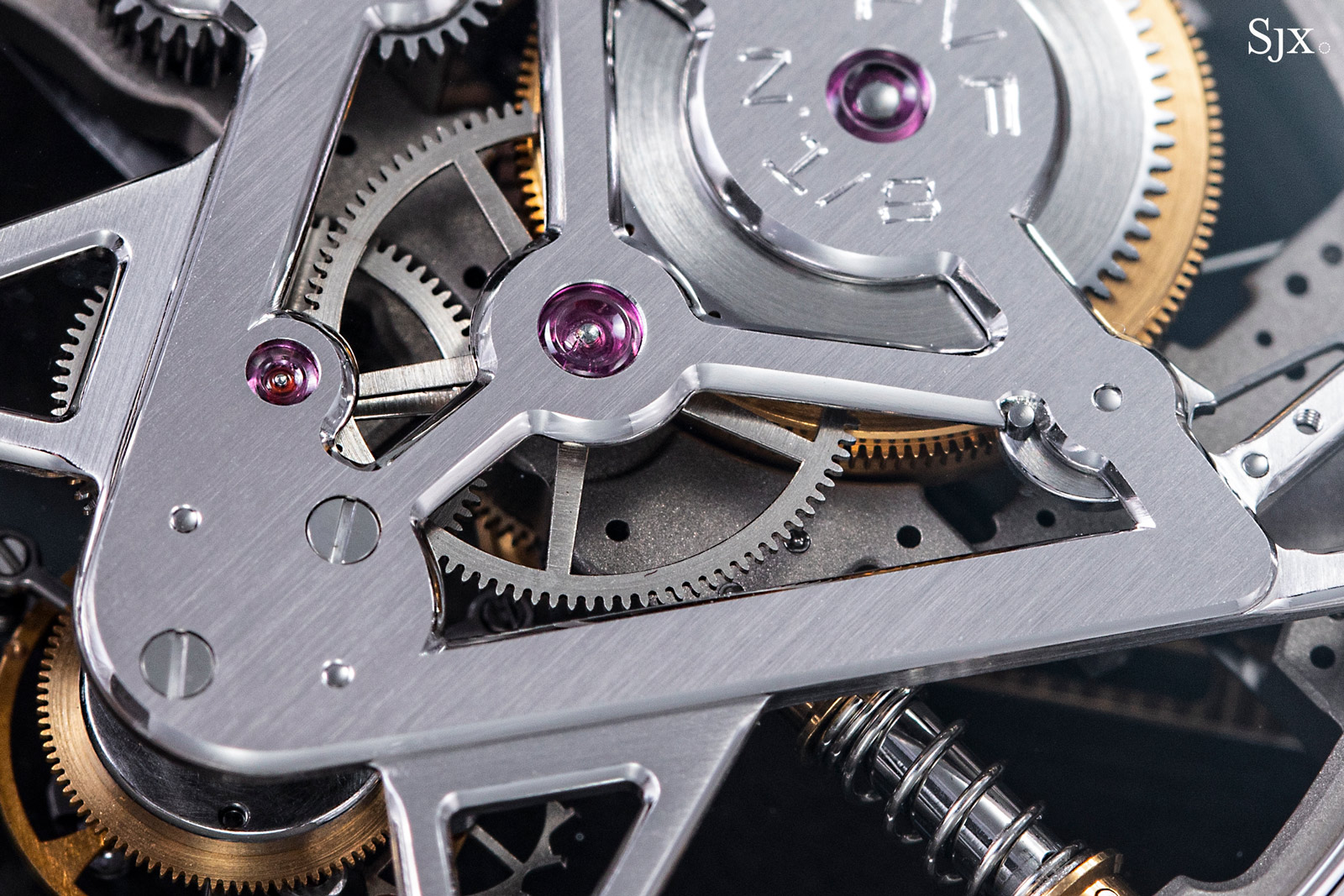
The thickness of the bridge is because it serves as part of the base plate, but that also means it sports broad, polished anglage
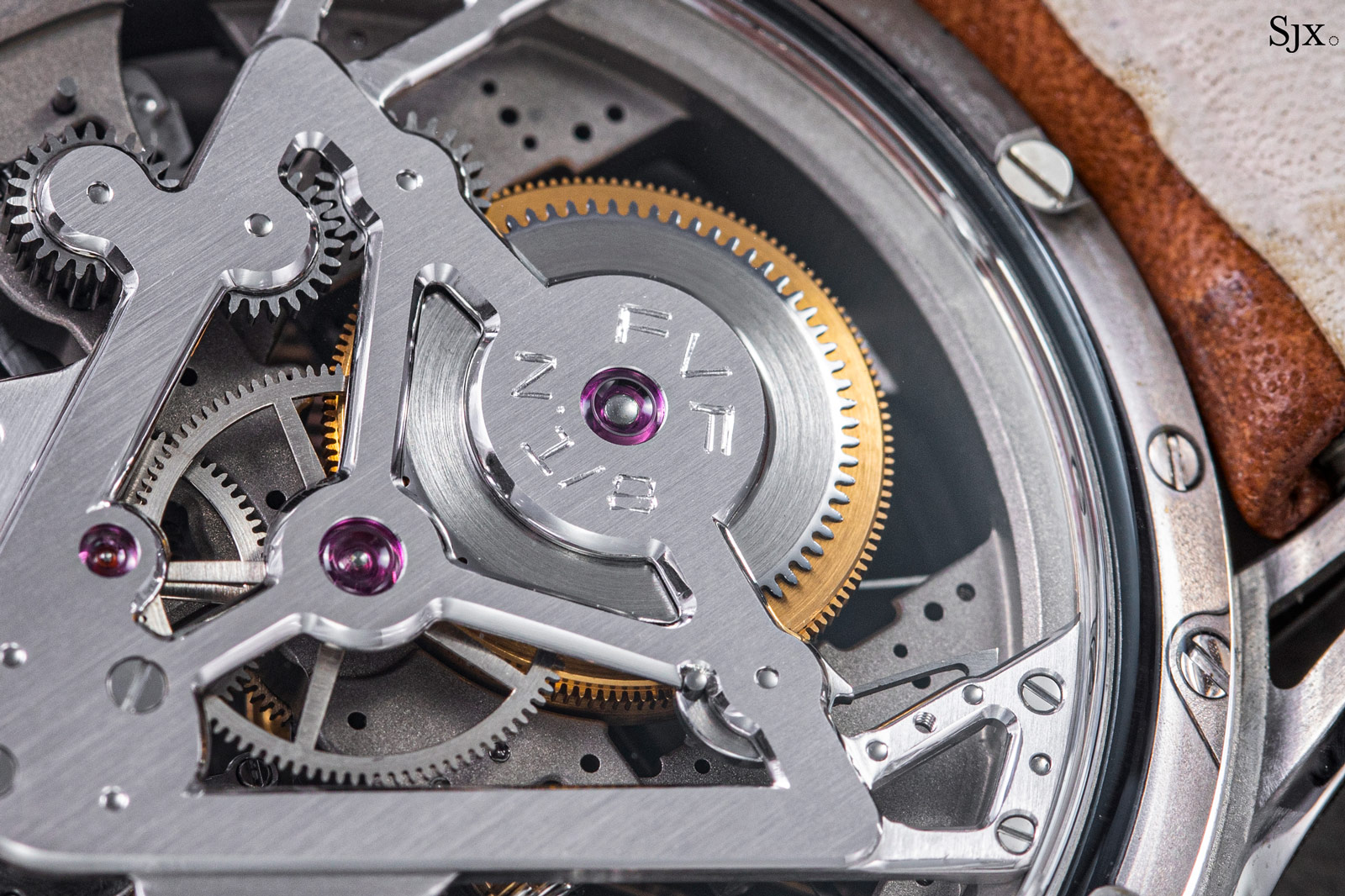
One element on the back I wish was done differently is the engraving around the jewel bearing for the barrel. It’s neatly milled but feels too basic
Concluding thoughts
Surprising in many respects, the FVF1 is smartly conceived and decorated finely enough to qualify as well finished. It’s a compelling watch and one that Mr Vila should have started with in 2005. But better late than never, and now that he has completed the FVF1, I look forward to his next chapter.
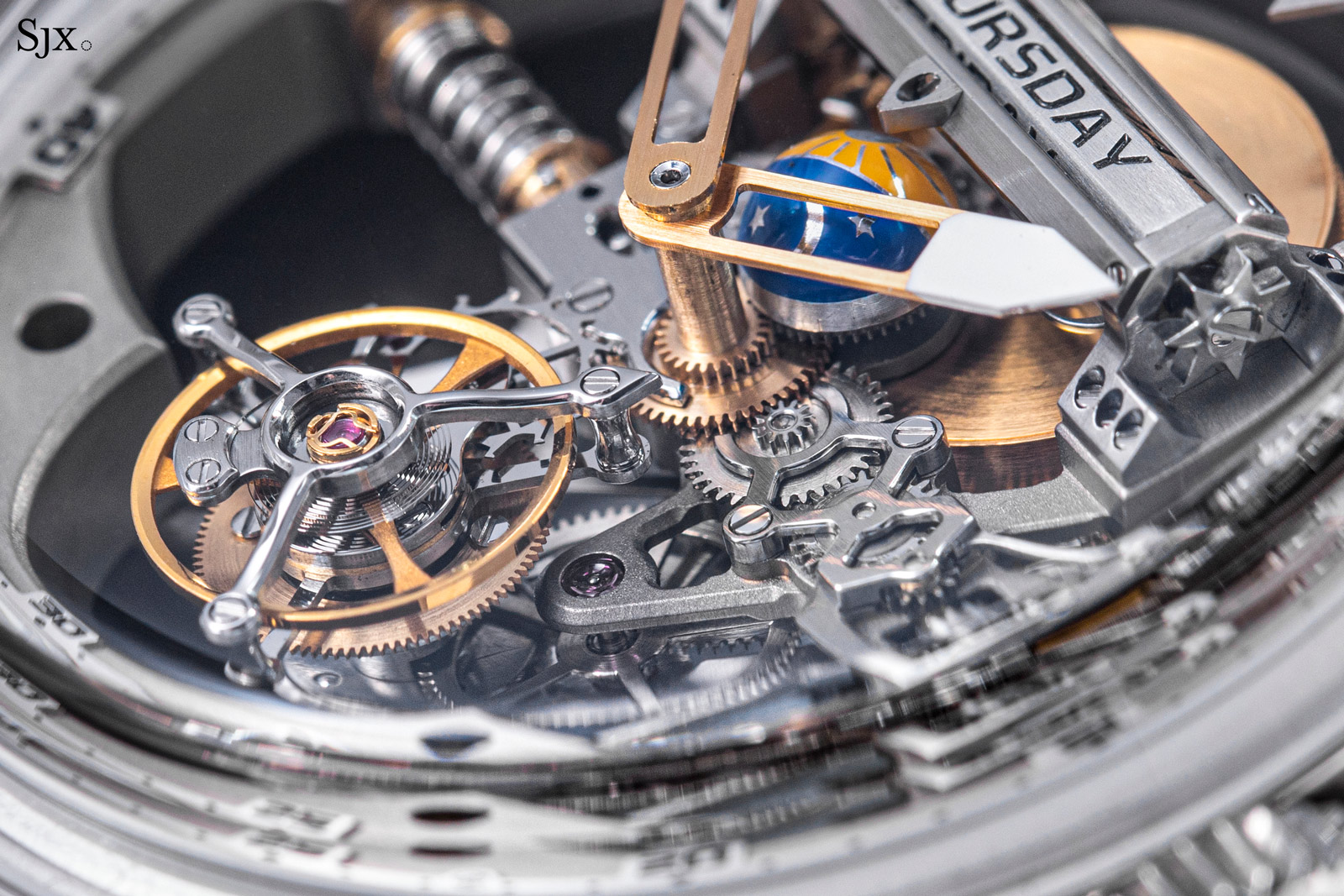
Key facts and price
Franc Vila FVF1 C2 Tourbillon Superligero
Diameter: 42.5 mm
Height: 13.9 mm
Material: Titanium case with steel case back
Crystal: Sapphire
Water resistance: 30 m
Movement: FVF1
Functions: Hours, minutes, day-night indicator, day of the week display, and tourbillon regulator
Winding: Hand wind
Frequency: 18,000 vibrations per hour (2.5 Hz)
Power reserve: 100 hours
Strap: Leather with pin buckle
Limited edition: Eight pieces
Availability: Direct from Franc Vila
Price: CHF125,000
For more, visit Francvilafounder.com.
Back to top.

